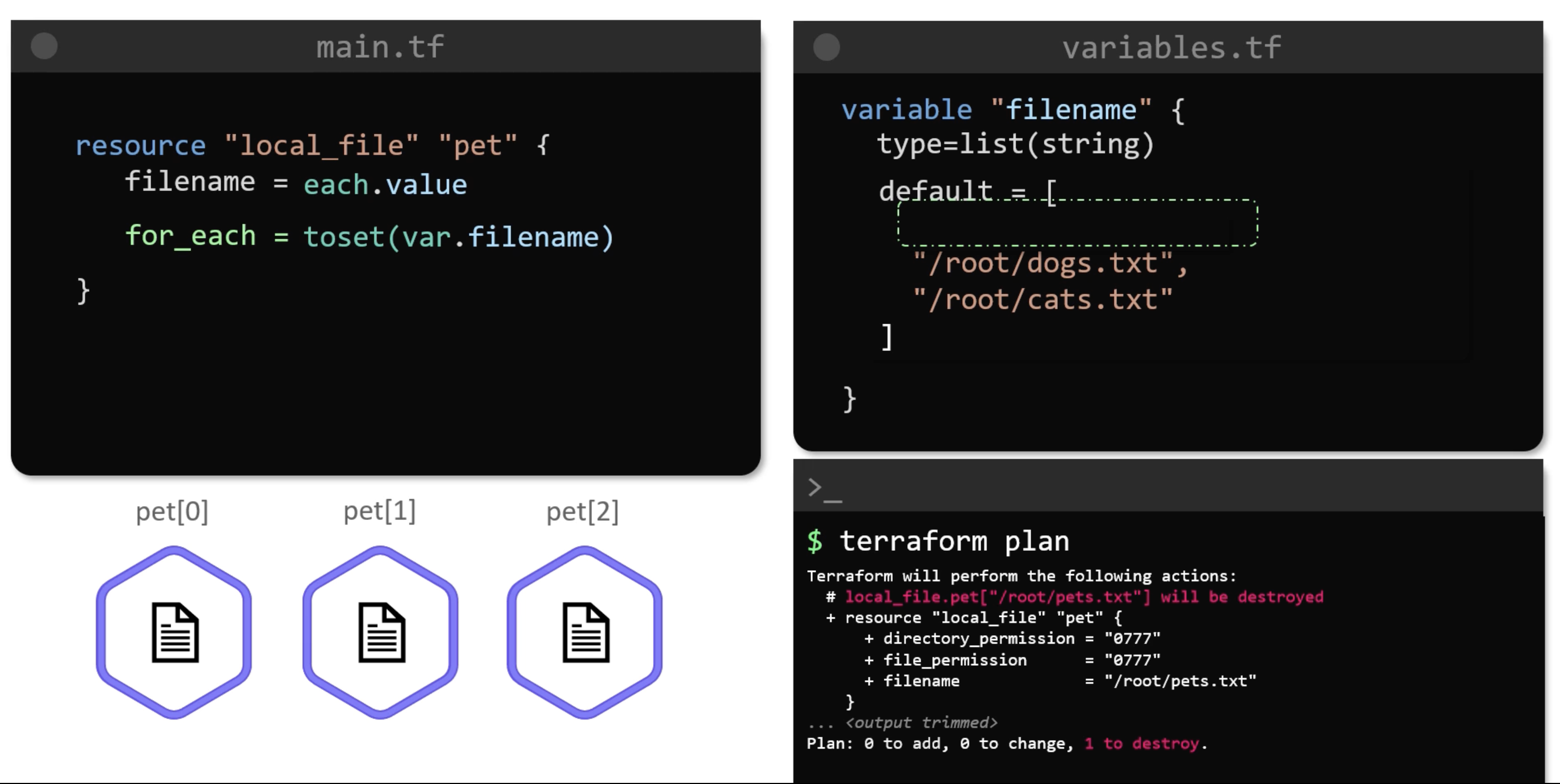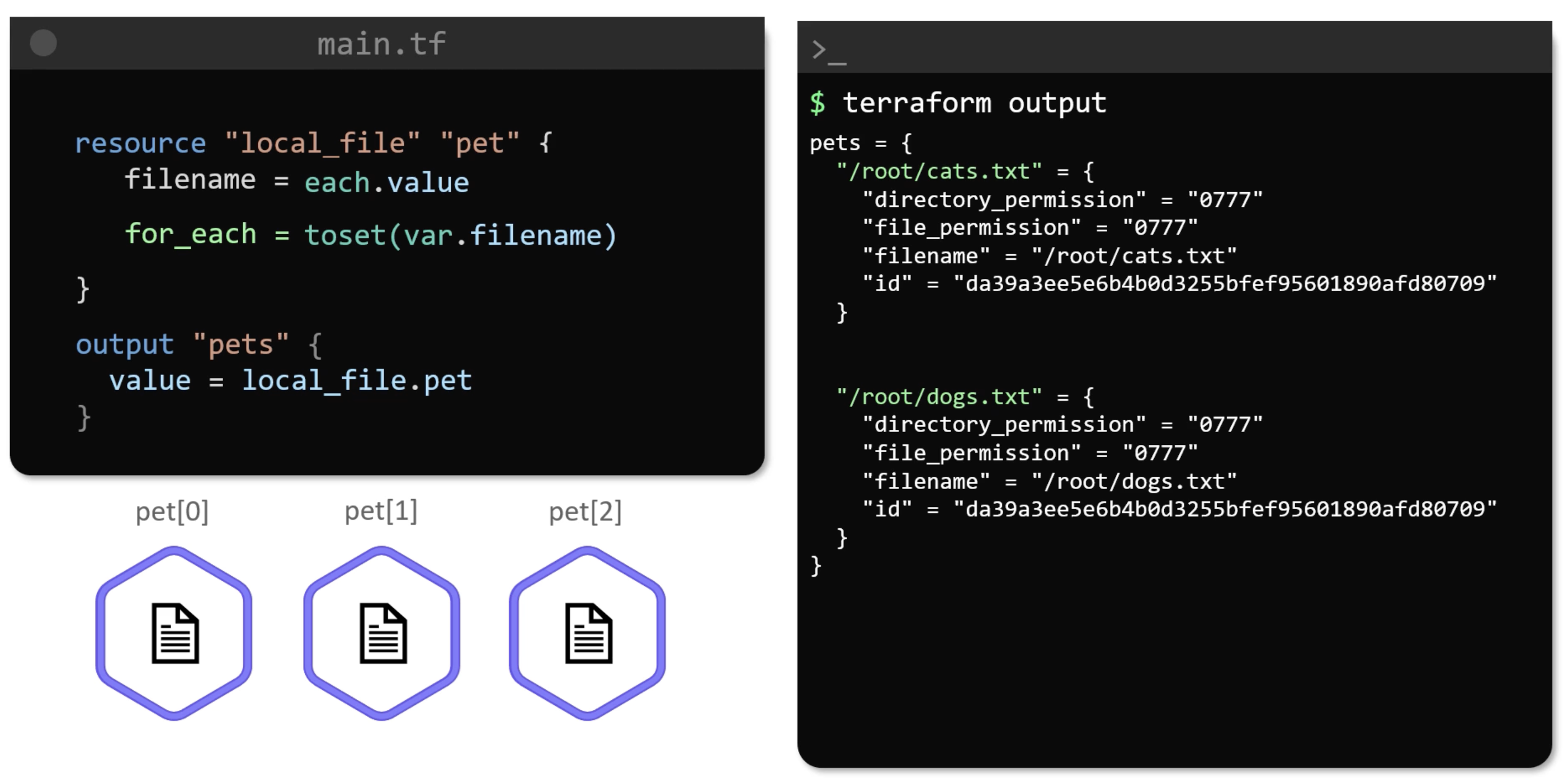Basics
Objectives
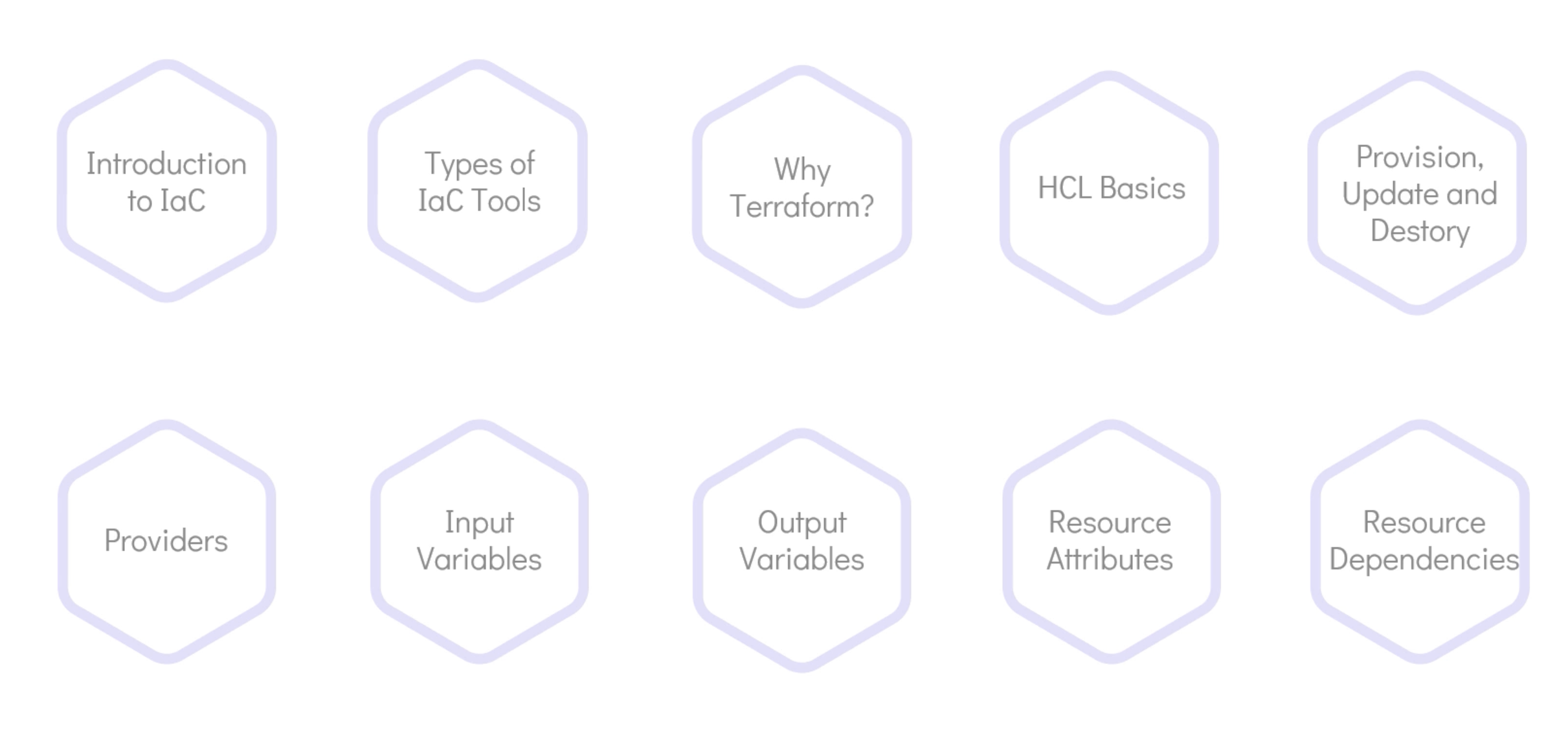
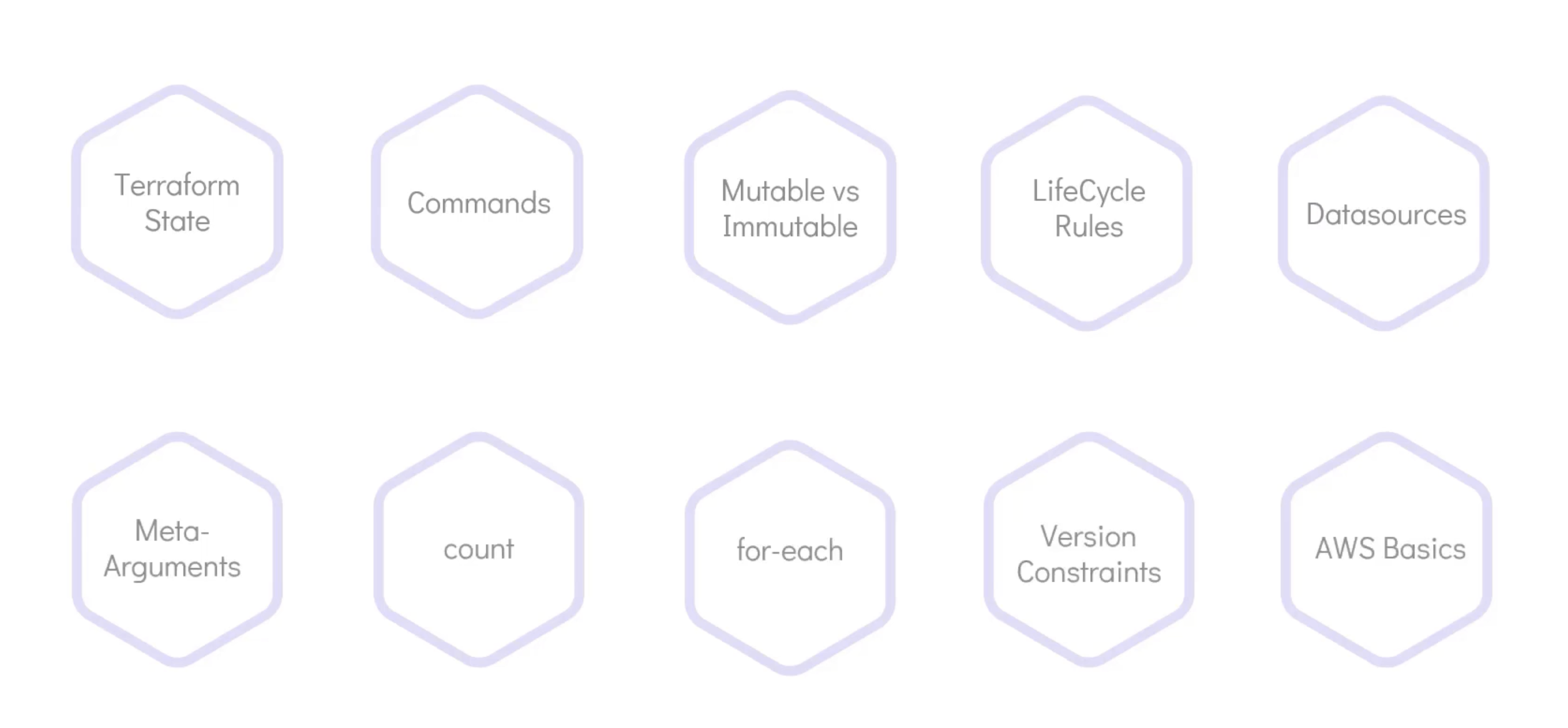
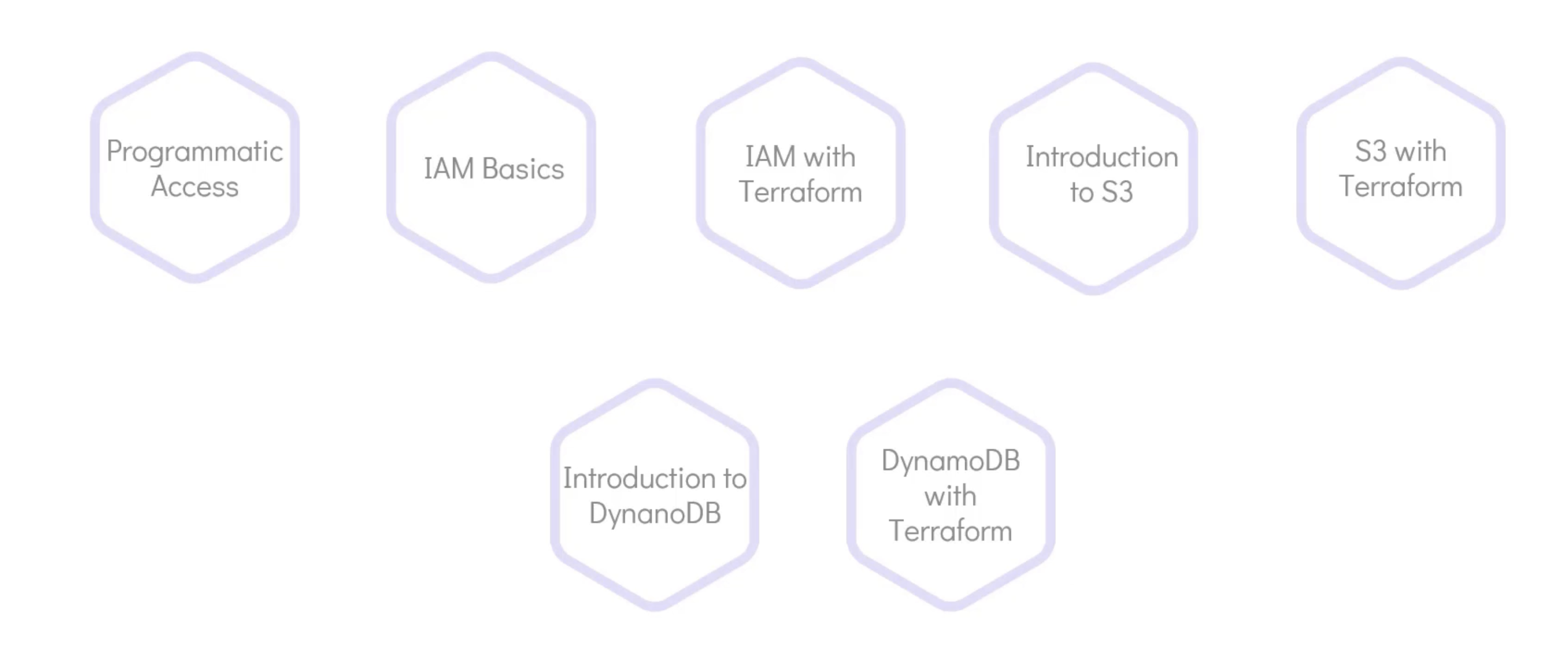
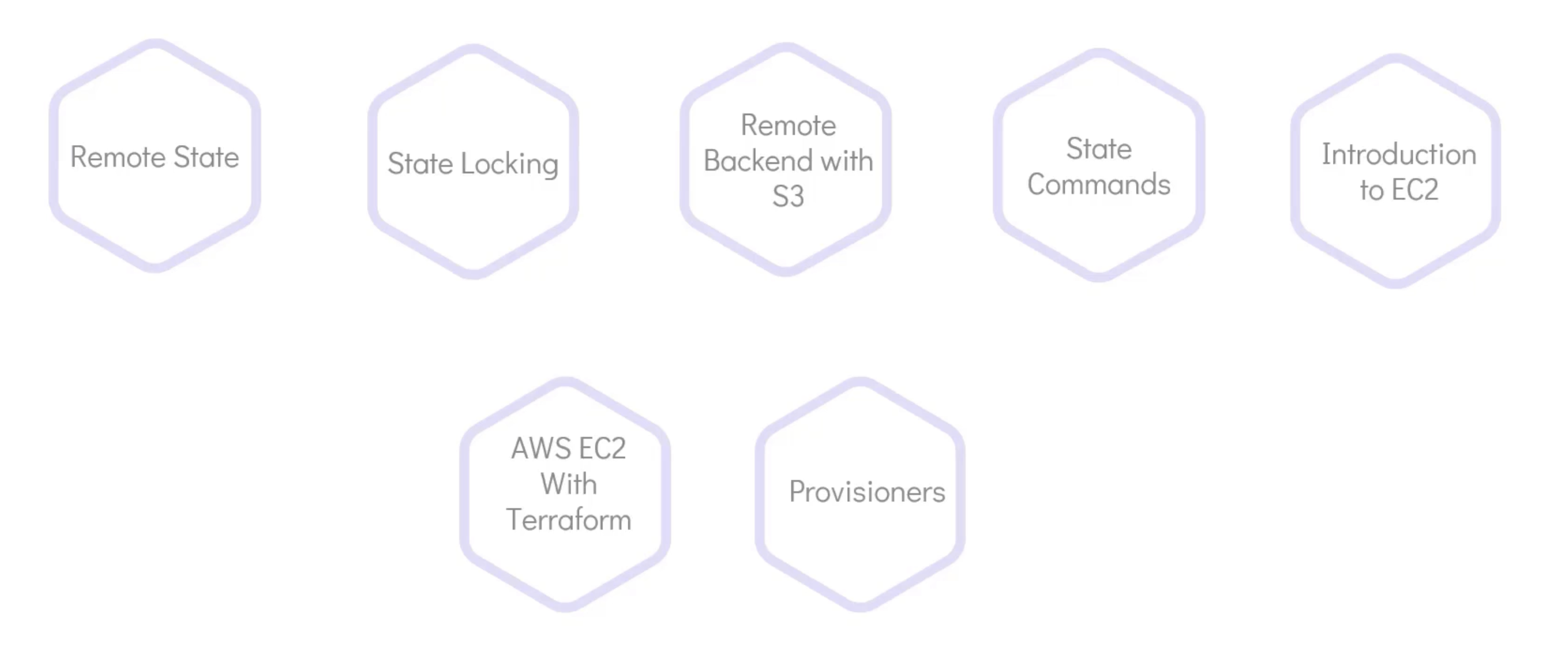
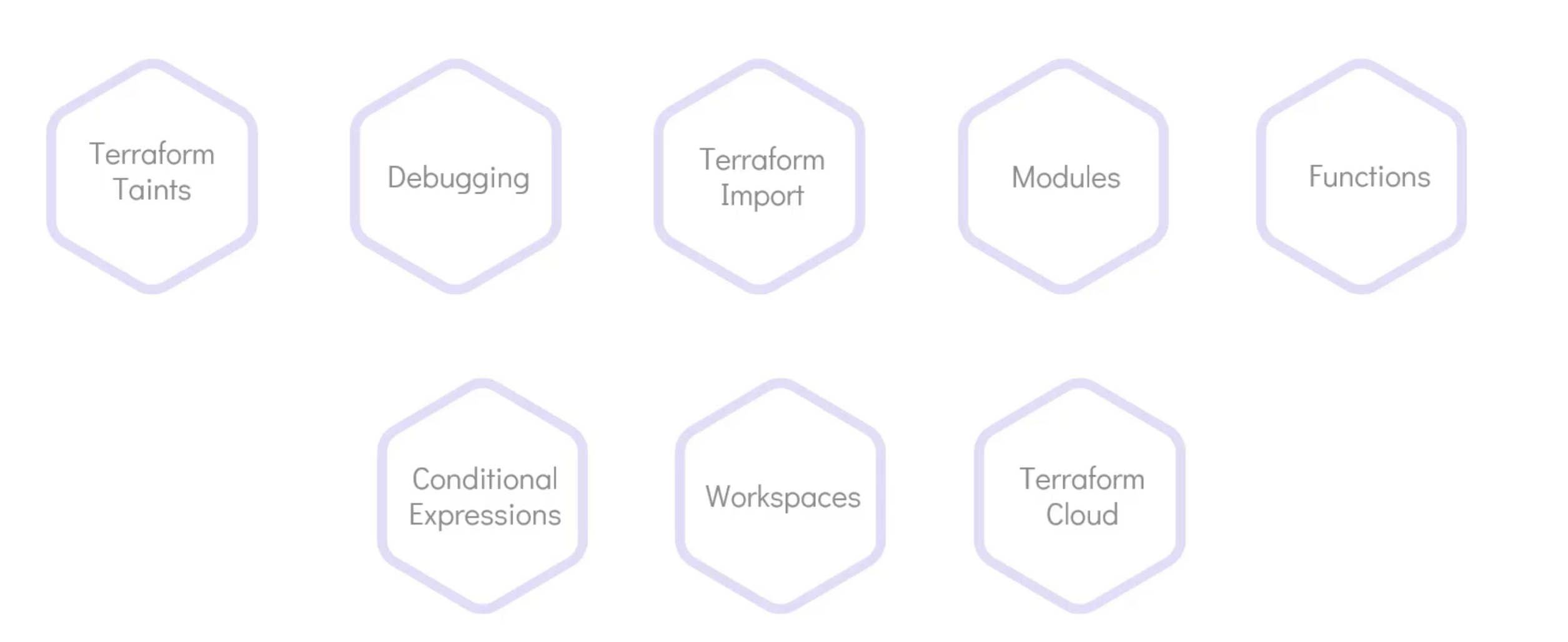
Old Way
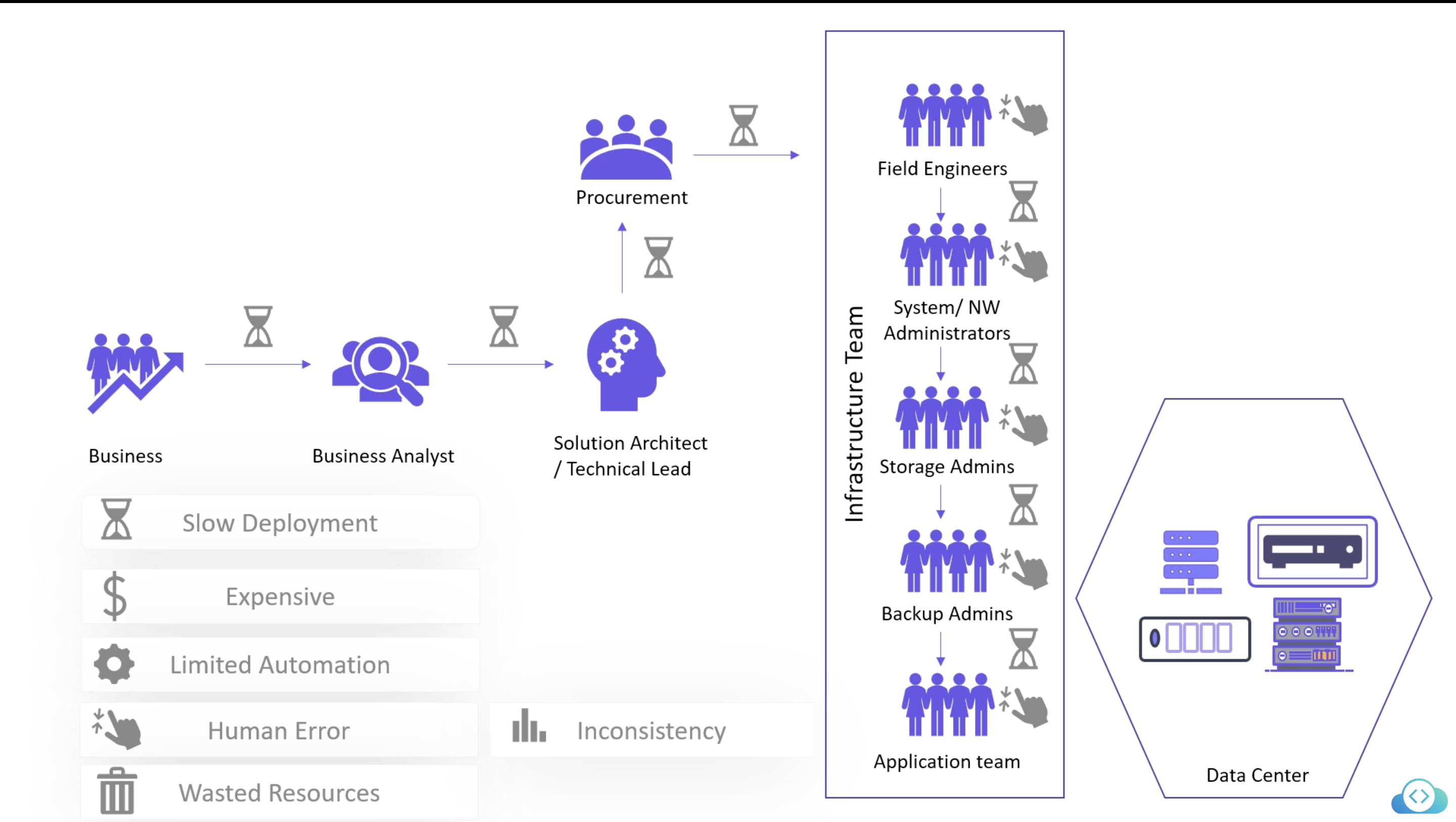
Infrastructure as Code (IaC)
- CLI
- Console
- Ansible
- Terraform
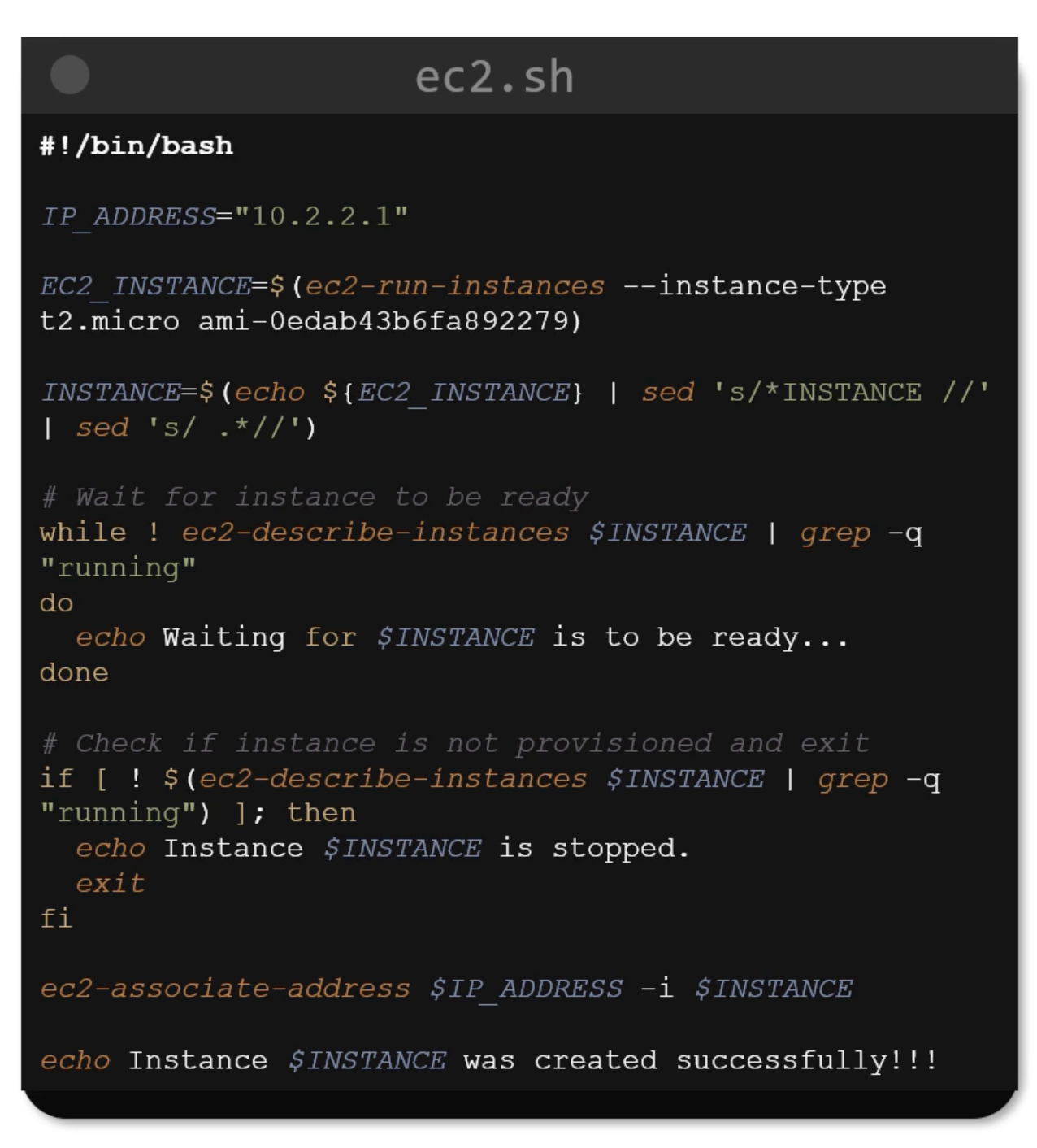

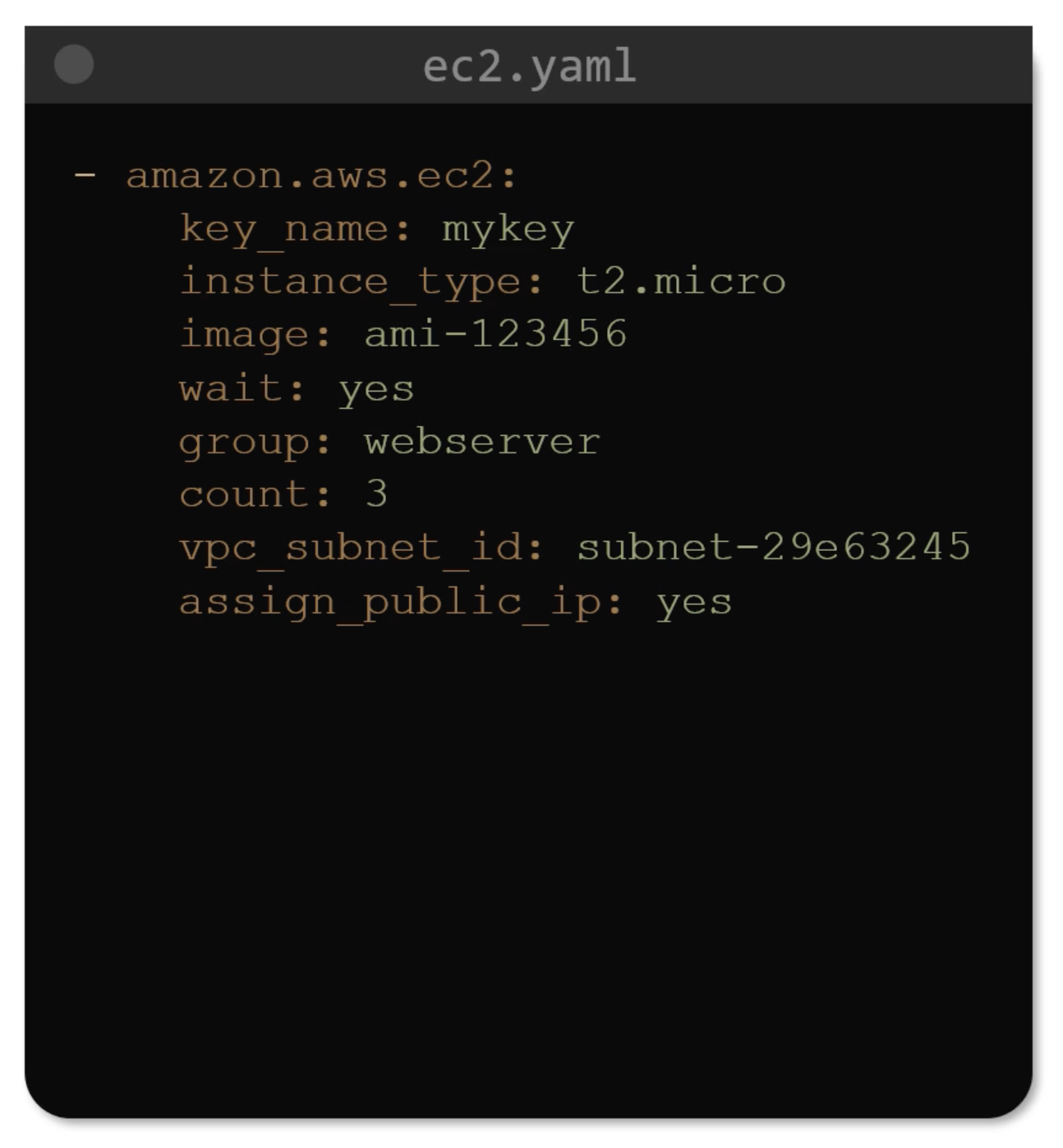
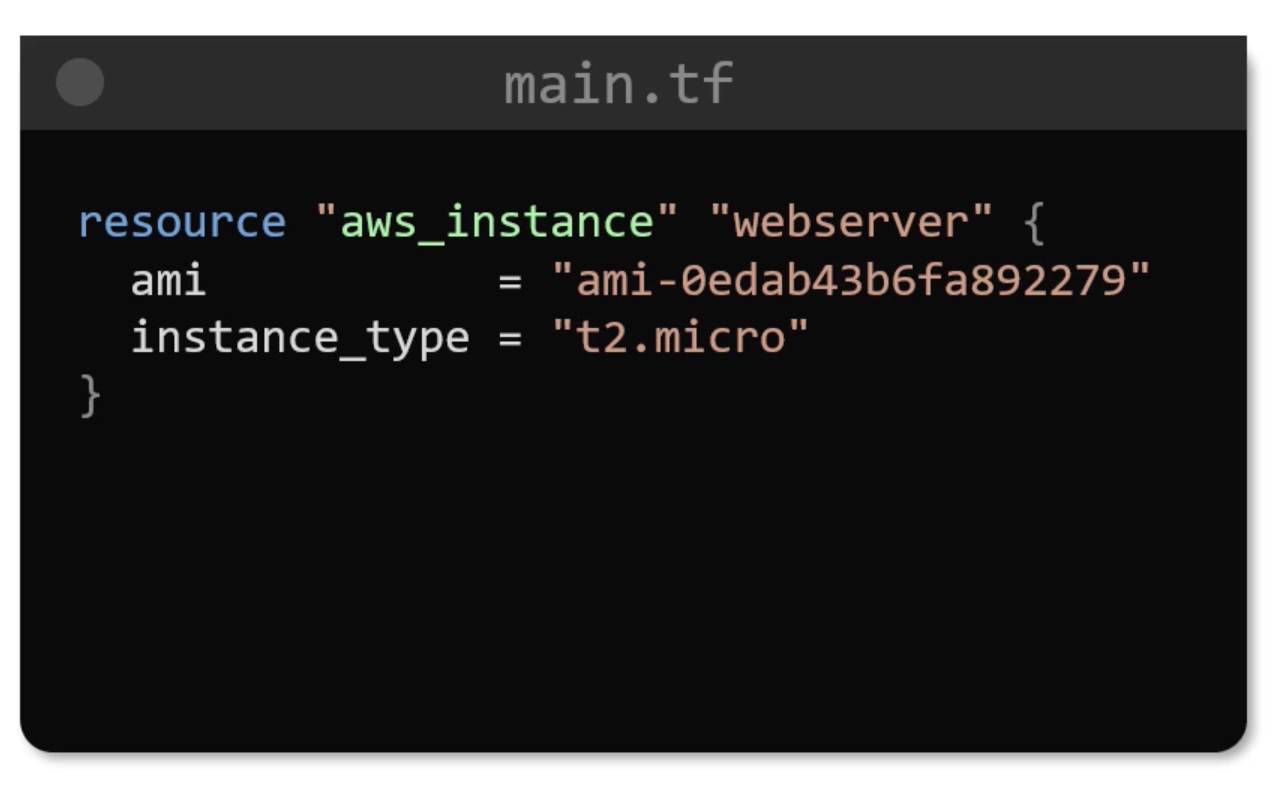
IaC Types
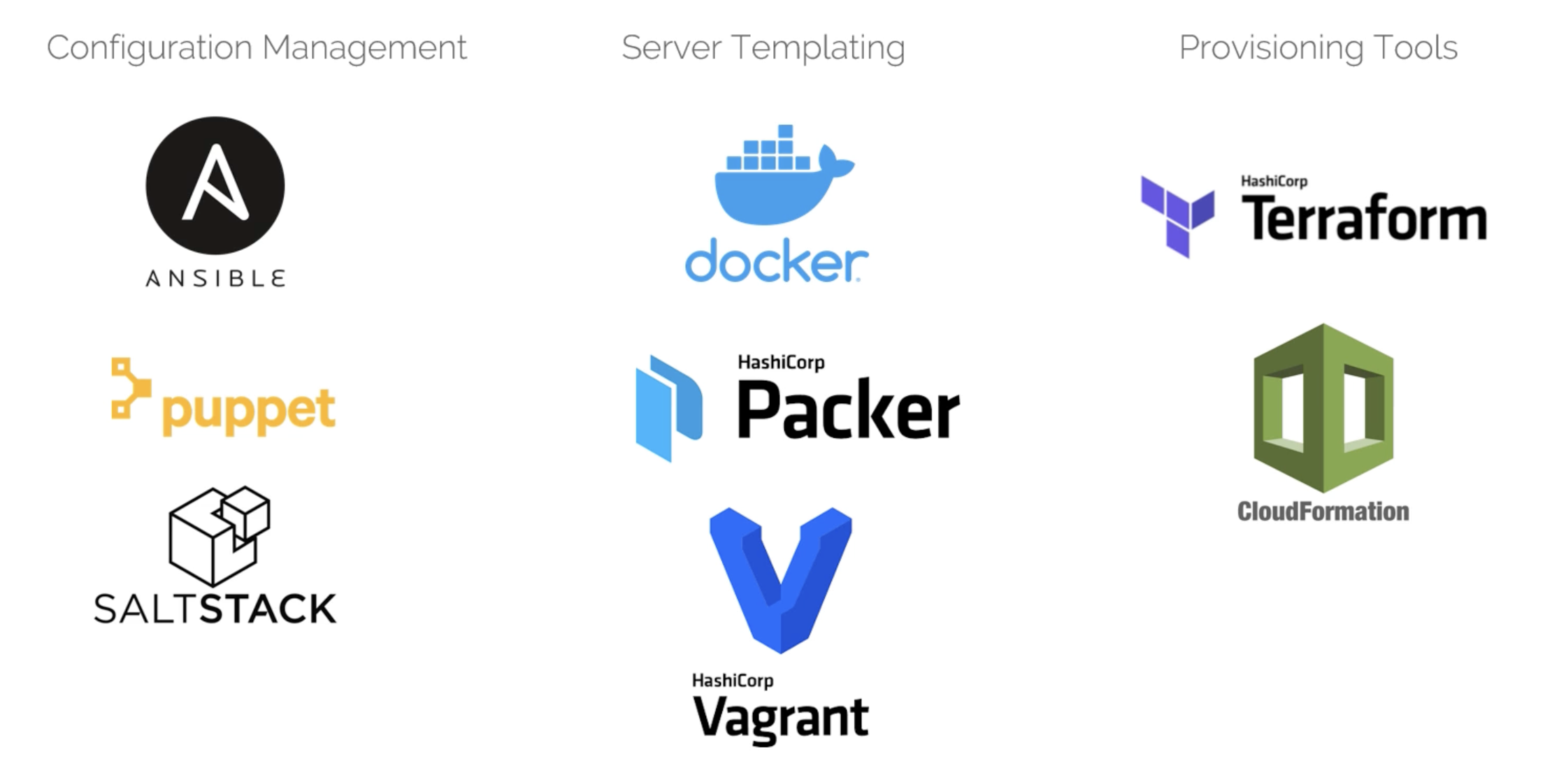
Configuration Management
- Ansible
- Puppet
- Chef
- SaltStack
Features
- Designed to install and manage software on existing servers.
- Maintains Standard Structure.
- Version Control.
Idempotent.
Server Templating Tools
These are tools that allows you to create a custom image of a vm or a container, e.g.:
- Docker.
- Packer.
- Vagrant.
Features
- Pre Install Software and Dependencies.
- Virtual Machine or Docker Images.
- Immutable Infrastructure.
Provisioning Tools
- Terraform.
- CloudFormation.
Features
Used to provision infrastructure resources, e.g.:
- Virtual Machines.
- Database Instances.
- Networking Components "VPCs, Subnets, Security Groups, ...etc".
Also, Terraform supports Multiple Providers.
Why Terraform?
- The code we wrote is the state we want our infrastructure to be in.
- Terraform works in three phases:
- Init: Initialize the projects and identify the providers.
- Plan: Drafts a plan to get to the target state.
- Apply: Apply the plan to the infrastructure.
- Every object that Terraform manages is called a
Resource. - Terraform manages the lifecycle of the resource from provisioning to configuration to decommissioning.
- Terraform stores the state of the infrastructure in a file called
terraform.tfstate, as it is seen in the real world. And it will ensure that the infrastructure is in the state that is defined in the configuration file. - The state is a blueprint of the infrastructure deployed in the cloud.
- Terraform is
Idempotent, which means that it will only make the necessary changes to the infrastructure to get it to the desired state. - Terraform can also import existing infrastructure into its state. Which was created manually or by other tools. And bring it under its management.
- Terraform Cloud and Enterprise offer a lot of features that help in managing the infrastructure and the team. Also, a central place to store the state file and manage the changes. And UI.
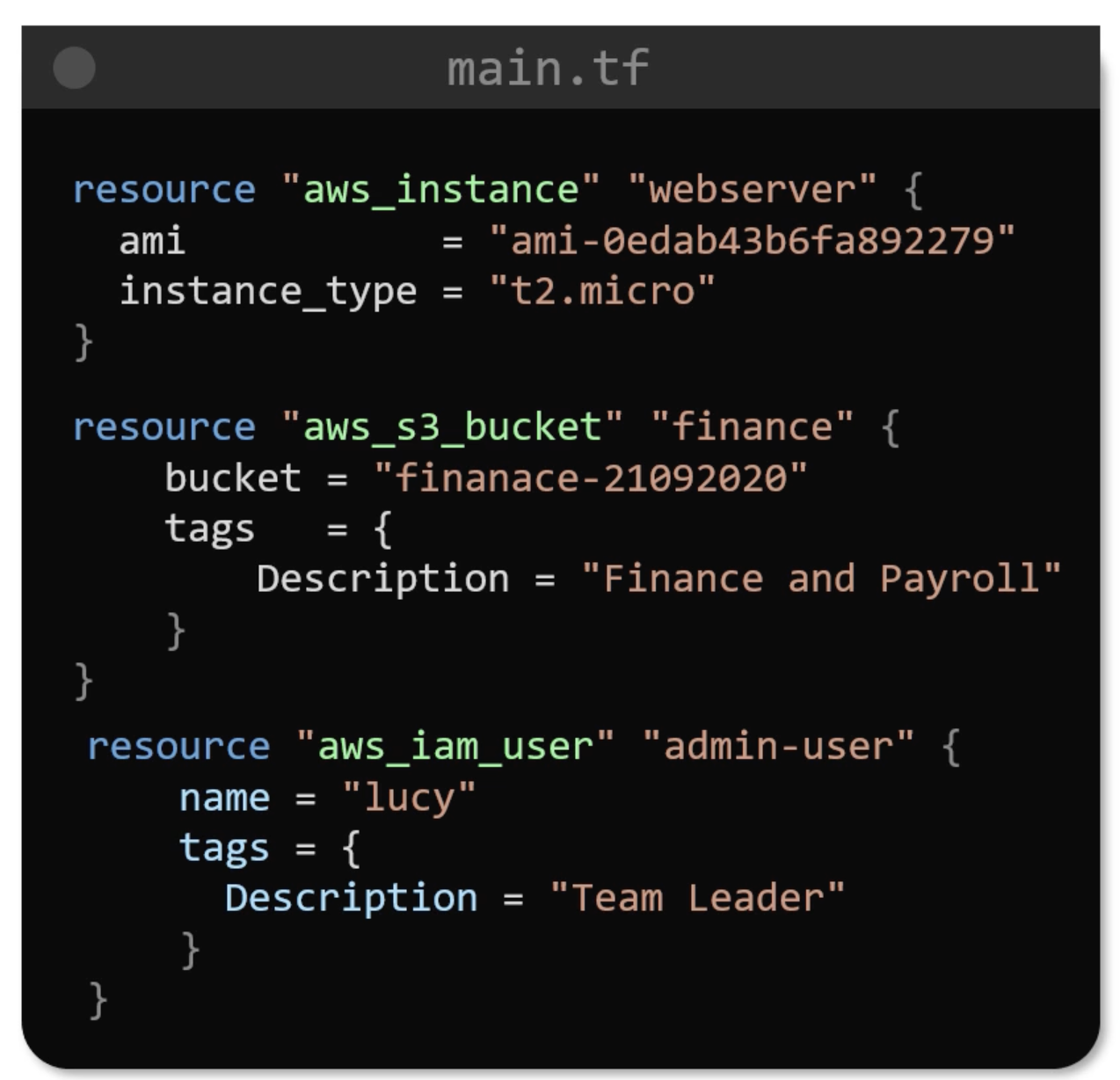
Installation
Visit the docs here.
wget -O- https://apt.releases.hashicorp.com/gpg | sudo gpg --dearmor -o /usr/share/keyrings/hashicorp-archive-keyring.gpg
echo "deb [signed-by=/usr/share/keyrings/hashicorp-archive-keyring.gpg] https://apt.releases.hashicorp.com $(lsb_release -cs) main" | sudo tee /etc/apt/sources.list.d/hashicorp.list
sudo apt update && sudo apt install terraform
HCL - Declarative Language

Resource
An object that Terraform can manage, e.g.:
- File on a localhost.
- vm on Cloud.
- Services like "S3 bucket, RDS, ...etc".
HCL Syntax
The HCL file consists of blocks, arguments. A block is defied within curly braces {}. It contains a set of arguments in key-value pairs format representing the configuration details.
<block> <parameters> {
<key> = <value>
<key> = <value>
}
You can access the docs here.
resource "local_file" "example" {
filename = "/tmp/example.txt"
content = "Hello, World!"
}
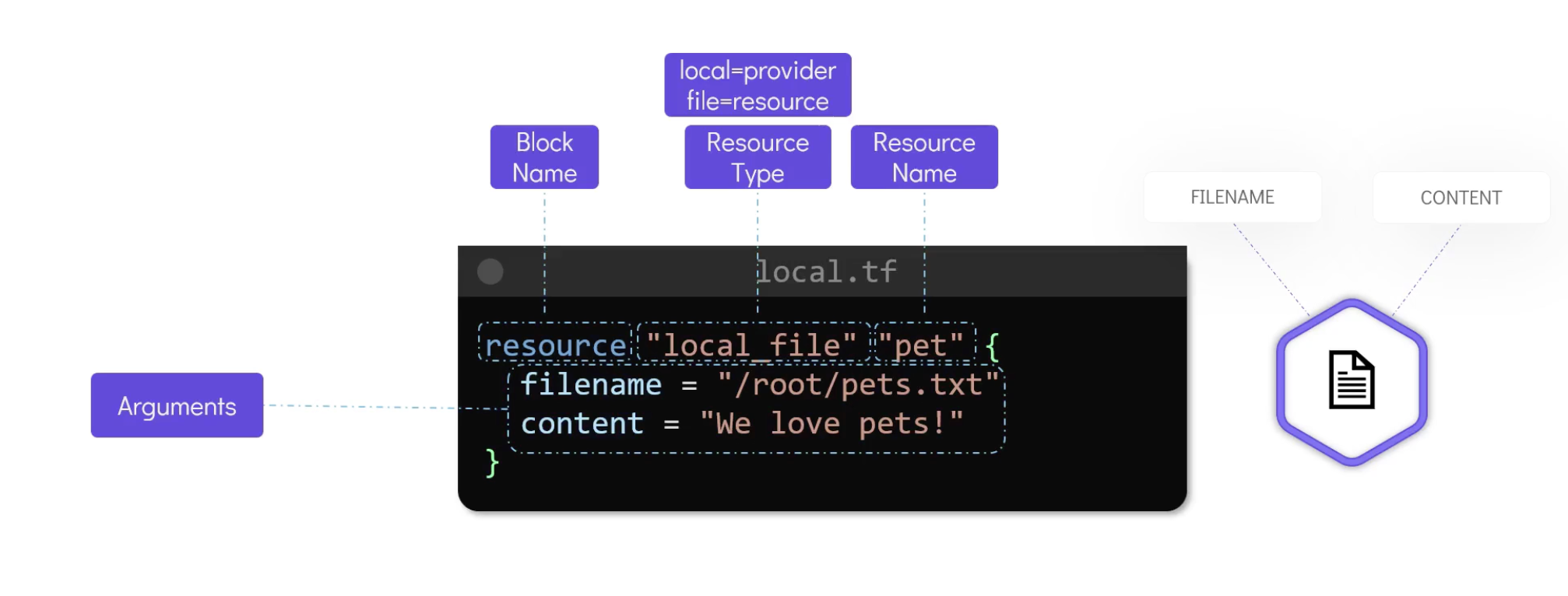
- The block name is
resourcekeyword. - The resource type is
local_file. It consists of two parts, the provider name before the underscorelocaland the resource after the underscoreafter. Note that it is a fixed value depends on the provider. - The resource name is
pet. It is a user-defined name and it is used to refer to the resource in other parts of the configuration. - The arguments are
filenameandcontent. They are the configuration details of the resource.
resource "aws_instance" "example" {
ami = "ami-0c55b159cbfafe1f0"
instance_type = "t2.micro"
}
resource "aws_s3_bucket" "example" {
bucket = "my-tf-test-bucket"
acl = "private"
}
Commands
terraform init
terraform plan
terraform apply -auto-approve
terraform show
terraform destroy -auto-approve
terraform init -upgrade
terraform output
terraform validate
terraform fmt
terraform providers
terraform providers mirror /root/terraform/new_local_file # will mirror the provider configuration to the new path
terraform refresh # sync the state file with the real-world infrastructure e.g. manual update. It is also ran by default before `plan` and `apply`. you can disable it by `terraform apply --refresh=false`.
terraform graph # visualize the dependency graph of the resources.
terraform graph | dot -Tsvg > graph.svg # save the graph to a file.
terraform state show local_file.file
Providers
You can access the docs here.
- Official: AWS, Azure, Google Cloud, ...
- Partner: Datadog, New Relic, ... A third party provider that has gone with partner process with HashiCorp.
- Community: A provider that is not officially supported by HashiCorp. Individuals or companies can create and publish their own providers.
The terraform init is a safe command to run multiple times, without affecting the infrastructure.
The plugins are downloaded in a hidden directory .terraform/plugins in the root of the project.
The plugin name that you see like hashicorp/local is the source address of the plugin. It is used to identify and download the plugin in the registry.
The first part of the name hashicorp is the Organizational namespace. It is followed by the type local which is the name of the provider.
The plugin name can also have an optional hostname at the front e.g. registry.terraform.io/hashicorp/local.
By default, Terraform will download the latest version of the plugin.
Configuration Directory
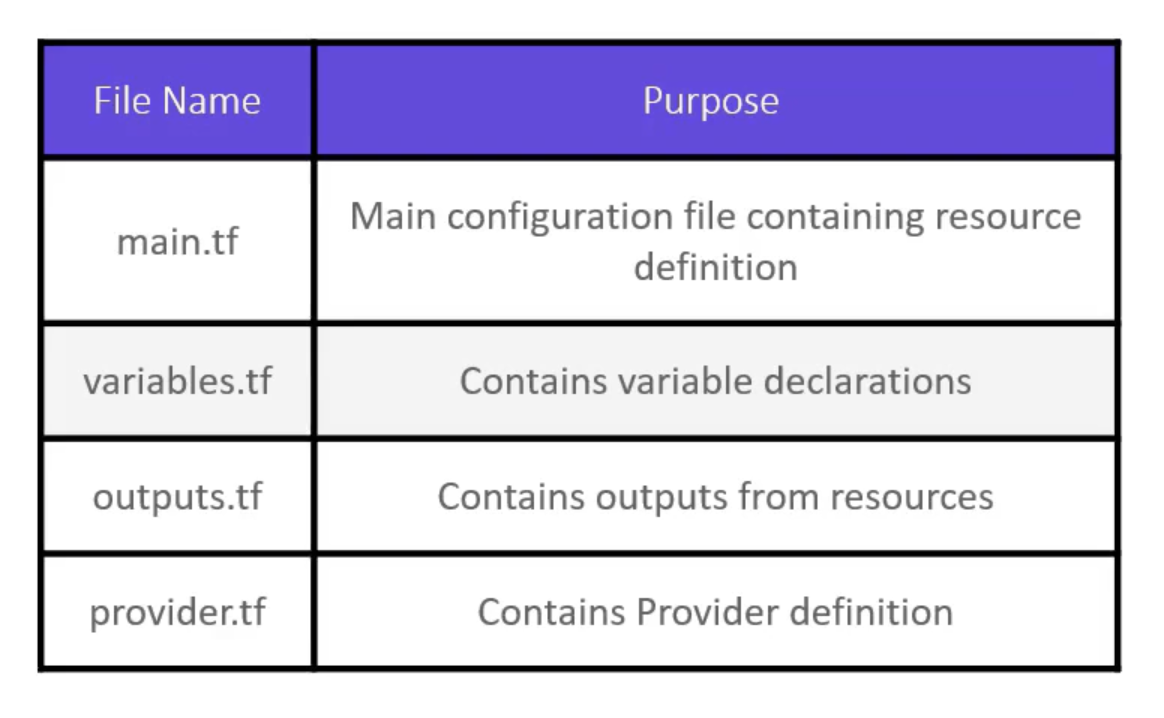
terraform {
required_providers {
linode = {
source = "linode/linode"
version = "1.13.3"
}
}
}
Multi Provider
resource "local_file" "pet_name" {
content = "We love pets!"
filename = "/root/pets.txt"
}
resource "random_pet" "my-pet" {
prefix = "Mrs"
separator = "."
length = "1"
}
Variables
- main.tf
- variables.tf
resource "local_file" "pet_name" {
filename = var.filename
content = var.content
}
resource "random_pet" "my-pet" {
prefix = var.prefix
separator = var.separator
length = var.length
}
variable "filename" {
description = "The filename of the file"
type = string
default = "/root/pets.txt"
}
variable "content" {
description = "The content of the file"
type = string
default = "We love pets!"
}
variable "prefix" {
description = "The prefix of the pet"
type = string
default = "Mrs"
}
variable "separator" {
description = "The separator of the pet"
type = string
default = "."
}
variable "length" {
description = "The length of the pet"
type = string
default = "1"
}
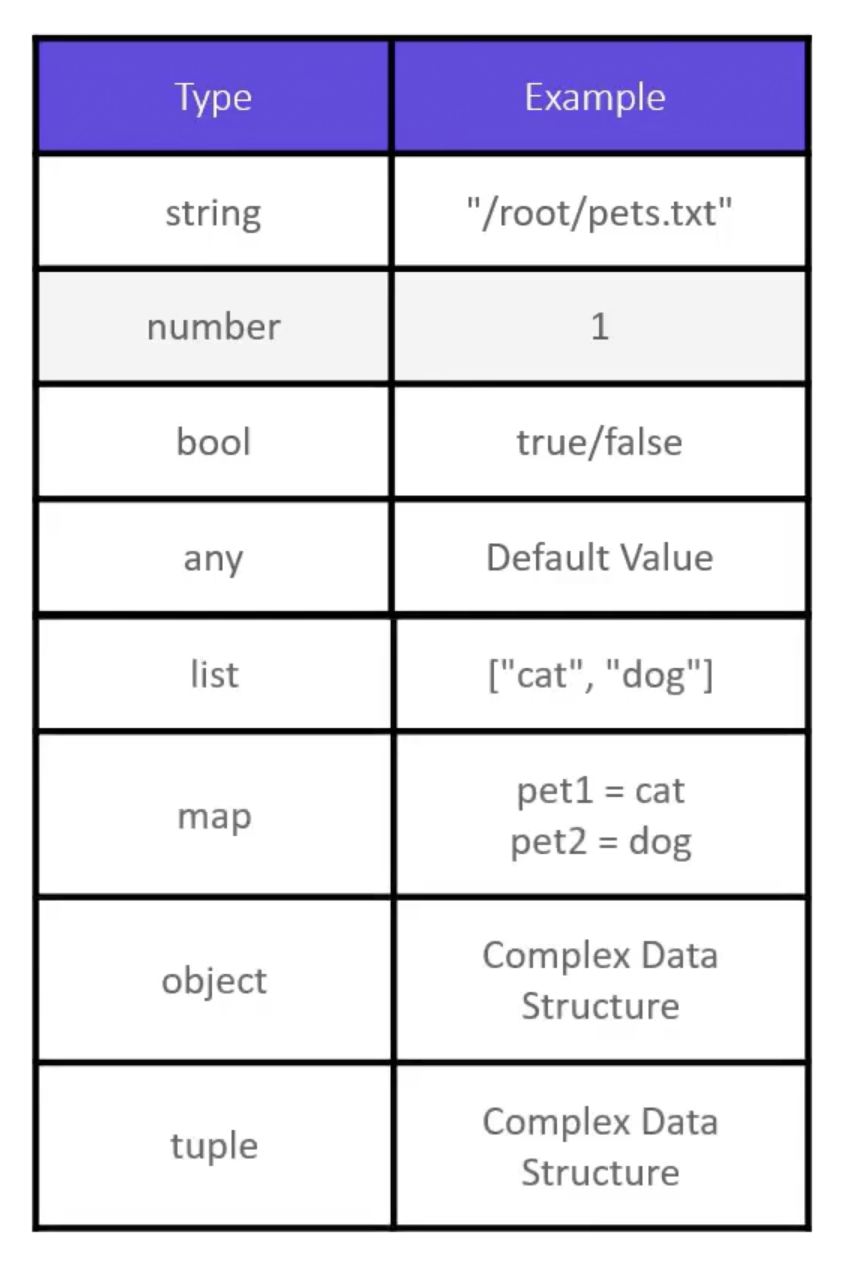
variable "prefix" {
default = ["Mrs", "Mr"]
type = list(string)
description = "The prefix of the pet"
}
variable "file-content" {
type = map
default = {
"statement-one" = "We love pets!"
"statement-two" = "We love animals!"
}
}
resource "random_pet" "my-pet" {
prefix = var.prefix[0]
separator = var.separator
length = var.length
}
resource local_file my-pet {
filename = "/root/pets.txt"
content = var.file-content["statement-one"]
}
variable "bella" {
type = object({
name = string
color = string
age = number
food = list(string)
favorite_pet = bool
})
default = {
name = "Bella"
color = "White"
age = 3
food = ["Chicken", "Fish"]
favorite_pet = true
}
}
variable kitty {
type = tuple([string, number, bool])
default = ["Kitty", 2, false]
}
Set is a list with unique elements.
Supply vars from CLI
variable "region" {
description = "The region to launch the instance"
type = string
}
terraform apply -var="region=us-west-1"
export TF_VAR_region=us-west-1
Variable Definition Files
Variable definition files can have any name and either .tfvars or .tfvars.json extension.
So:
terraform.tfvarsterraform.tfvars.json*.auto.tfvars*.auto.tfvars.json- Or use
-var-fileflag to specify the file. E.g.terraform apply -var-file= variables.tfvars.
filename = "/root/pets.txt"
content = "We love pets!"
prefix = "Mrs"
separator = "."
length = "1"
Precedence
You can view the docs here.

Resource attributes
resource "time_static" "example" {}
resource "local_file" "time" {
filename = "/tmp/time.txt"
content = time_static.example.rfc3339
}
Resource Dependencies
- Implicit Dependencies.
resource "local_file" "pet" {
filename = var.filename
content = "My favv pet is ${random_pet.my-pet.id}"
}
resource "random_pet" "my-pet" {
prefix = var.prefix
separator = var.separator
length = var.length
}
- Explicit Dependencies.
resource "local_file" "pet" {
filename = var.filename
content = "My favv pet is Mr. Chattie"
depends_on = [
random_pet.my-pet
]
}
resource "random_pet" "my-pet" {
prefix = var.prefix
separator = var.separator
length = var.length
}
resource "local_file" "whale" {
filename = "/root/whale"
content = "whale"
depends_on = [ local_file.krill ]
}
resource "local_file" "krill" {
filename = "/root/krill"
content = "krill"
}
Output Variables
The best use of terraform output is:
- When you want to quickly display details about the provisioned infrastructure on the screen.
- Or to feed the output to another IaC tool or script.
resource "random_pet" "my-pet" {
prefix = var.prefix
separator = var.separator
length = var.length
}
output pet-name {
value = random_pet.my-pet.id
description = "Record the value of the pet name"
}
Terraform State
terraform.tfstatefile is the state file that contains the current state of the infrastructure. It is a JSON file. Terraform uses it as a source of truth to know what is currently deployed in the real-world infrastructure.
Terraform uses state file to track dependencies between resources. E.g. you removed two resources, so know looking only at configuration files. You can't know which one to remove first. But the state file will tell you that.
Also, for performance reasons. It is not reasonable to reconcile the infrastructure with the configuration files every time you run a terraform command. So, Terraform uses the state file to know what is currently deployed and what is not.
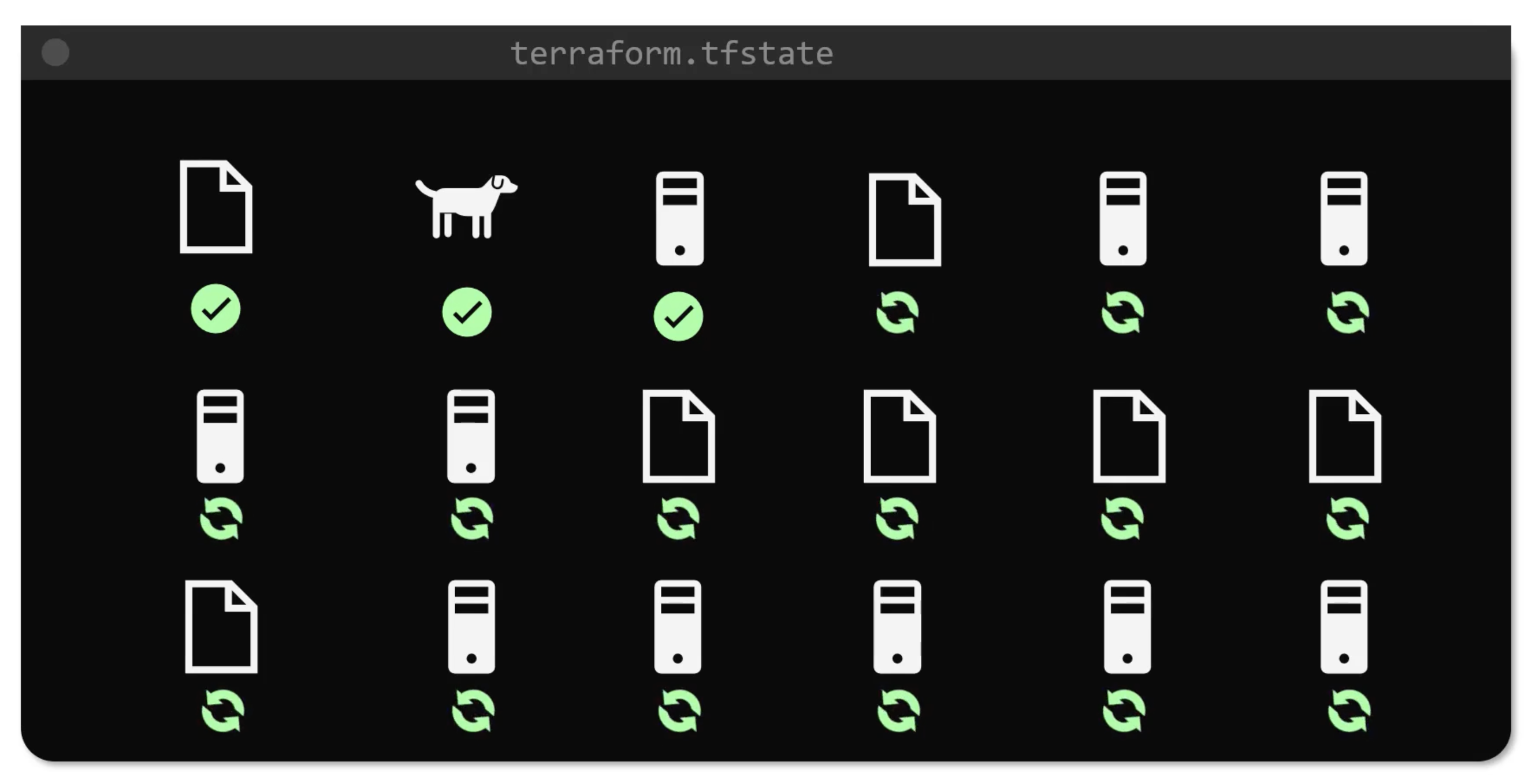
Terraform will use cached attributes from the state file. It will not refresh the state from the real-world infrastructure. It is useful when you want to quickly apply changes to the infrastructure without waiting for the refresh to complete.
terraform apply --refresh=false
- State files should be kept secure and private. It is suggested to use a remote backend to store the state file. E.g. Terraform Cloud, S3, Azure Blob Storage, ...etc.
- Configuration files should not contain sensitive data. E.g. passwords, keys, ...etc. And are recommended to be stored in distributed version control systems.
You should never attempt to modify the state file manually. Relay on Terraform state commands to manage the state file.
Configuration Drift
- Configuration Drift is the difference between the real-world infrastructure and the configuration files. It leaves the infrastructure in a complex state. Which will make any subsequent changes to the infrastructure difficult to manage.
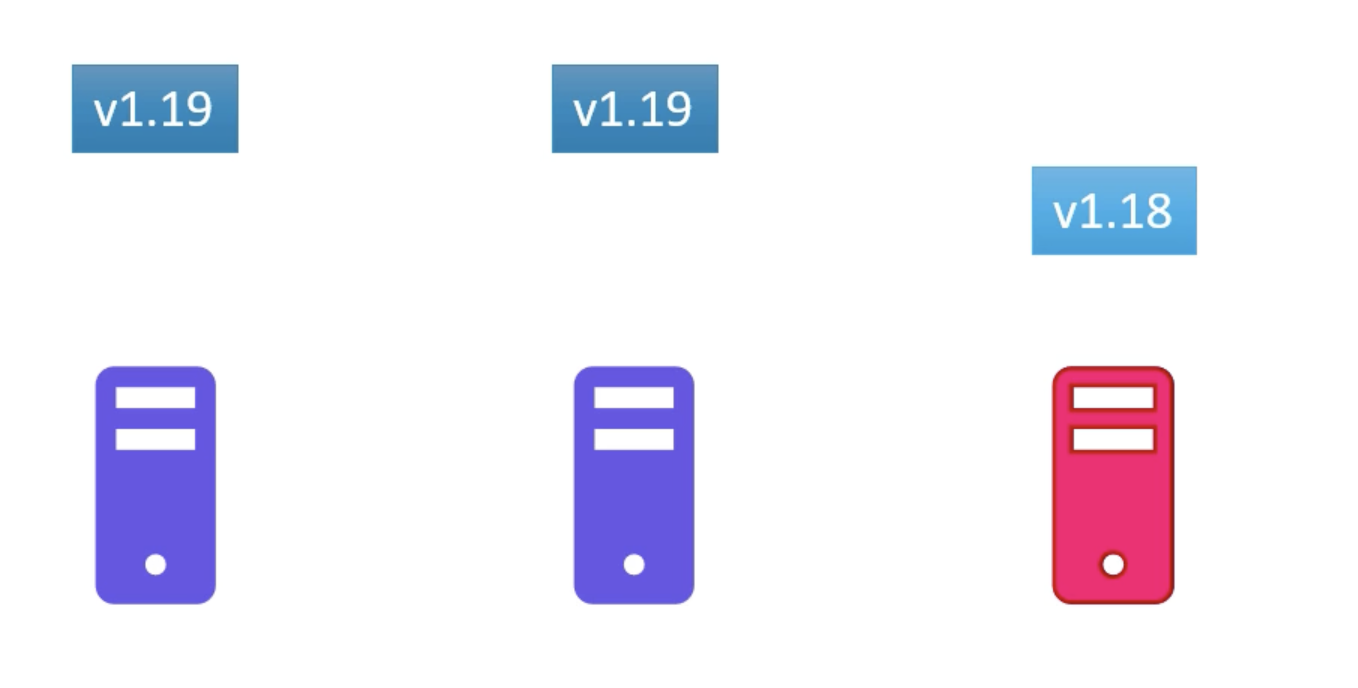
Lifecycle Rules
resource "aws_instance" "example" {
ami = "ami-0c55b159cbfafe1f0"
instance_type = "t2.micro"
lifecycle {
create_before_destroy = true
// or
prevent_destroy = true
}
}
Ignore changes
resource "aws_instance" "example" {
ami = "ami-0c55b159cbfafe1f0"
instance_type = "t2.micro"
tags = {
Name = "example"
}
lifecycle {
ignore_changes = [
tags["Name"],
]
# or ignore_changes = all
}
}
Data Sources
resource "local_file" "pet" {
filename = var.filename
content = "My favv pet is ${data.local_file.dogs.content}"
}
data "local_file" "dogs" {
filename = "/root/dogs.txt"
}
output "os-version" {
value = data.local_file.content
}
data "local_file" "os" {
filename = "/etc/os-release"
}
Meta Arguments
Meta arguments can be used with any resource block, e.g.:
depends_onlife_cyclecount
Count
- v1
- v2
variable "filename" {
type = string
default = [
"/root/pets.txt",
"/root/dogs.txt",
"/root/cats.txt"
]
}
resource "local_file" "pet" {
filename = var.filename[count.index]
count = 3
}
variable "filename" {
type = string
default = [
"/root/pets.txt",
"/root/dogs.txt",
"/root/cats.txt",
"/root/cows.txt",
"/root/whales.txt"
]
}
resource "local_file" "pet" {
filename = var.filename[count.index]
count = length(var.filename)
}
If you removed "/root/pets.txt", instead of destroying only one resource. Terraform will replace two resources and destroy one.
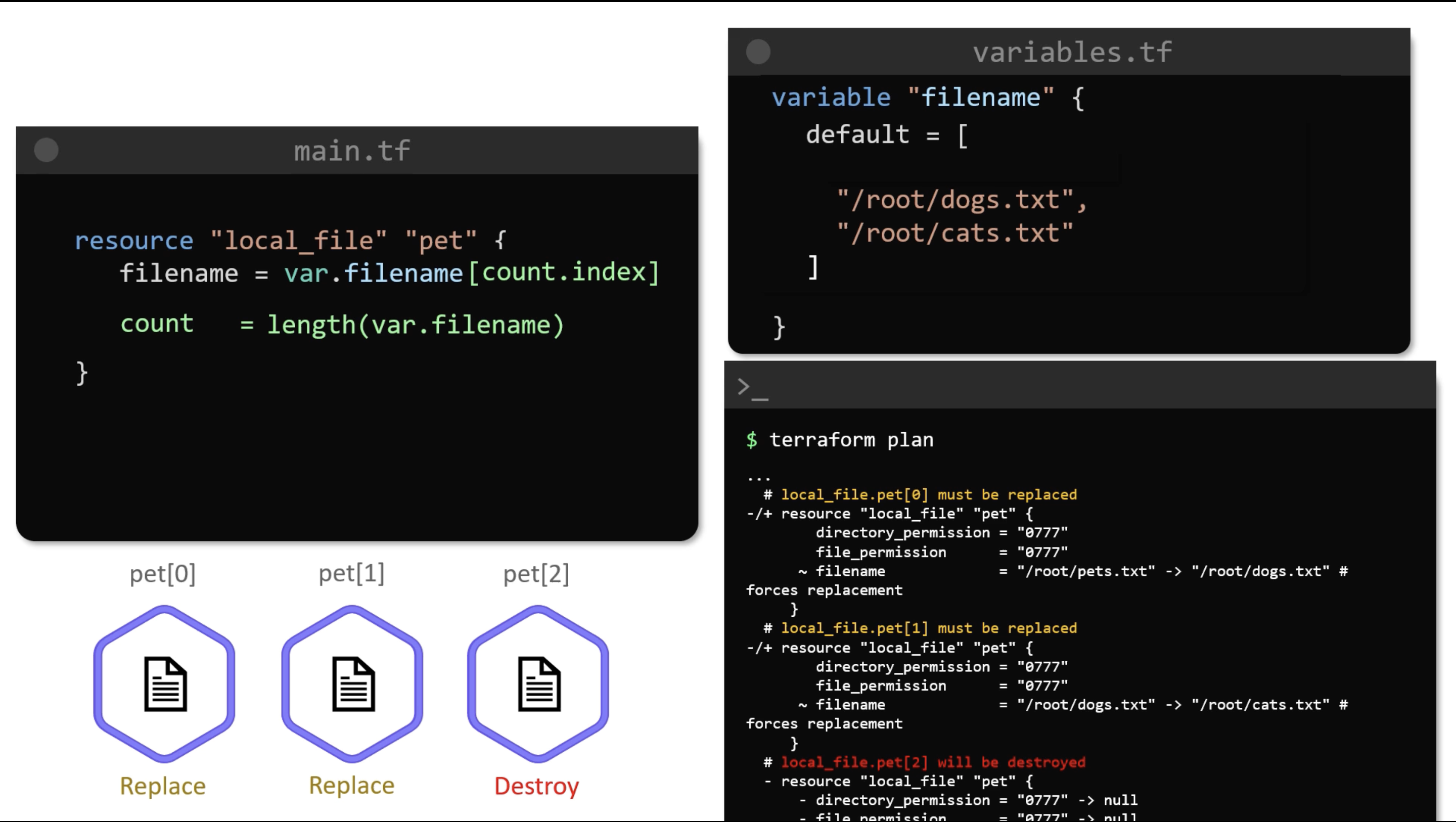
When you use count, the resources become a list of resources.
Example
variable "filename" {
type = string
default = [
"/root/pets.txt",
"/root/dogs.txt",
"/root/cats.txt",
"/root/cows.txt",
"/root/whales.txt"
]
}
resource "local_file" "pet" {
filename = var.filename[count.index]
count = length(var.filename)
}
output "pets" {
value = local_file.pet
}
Output
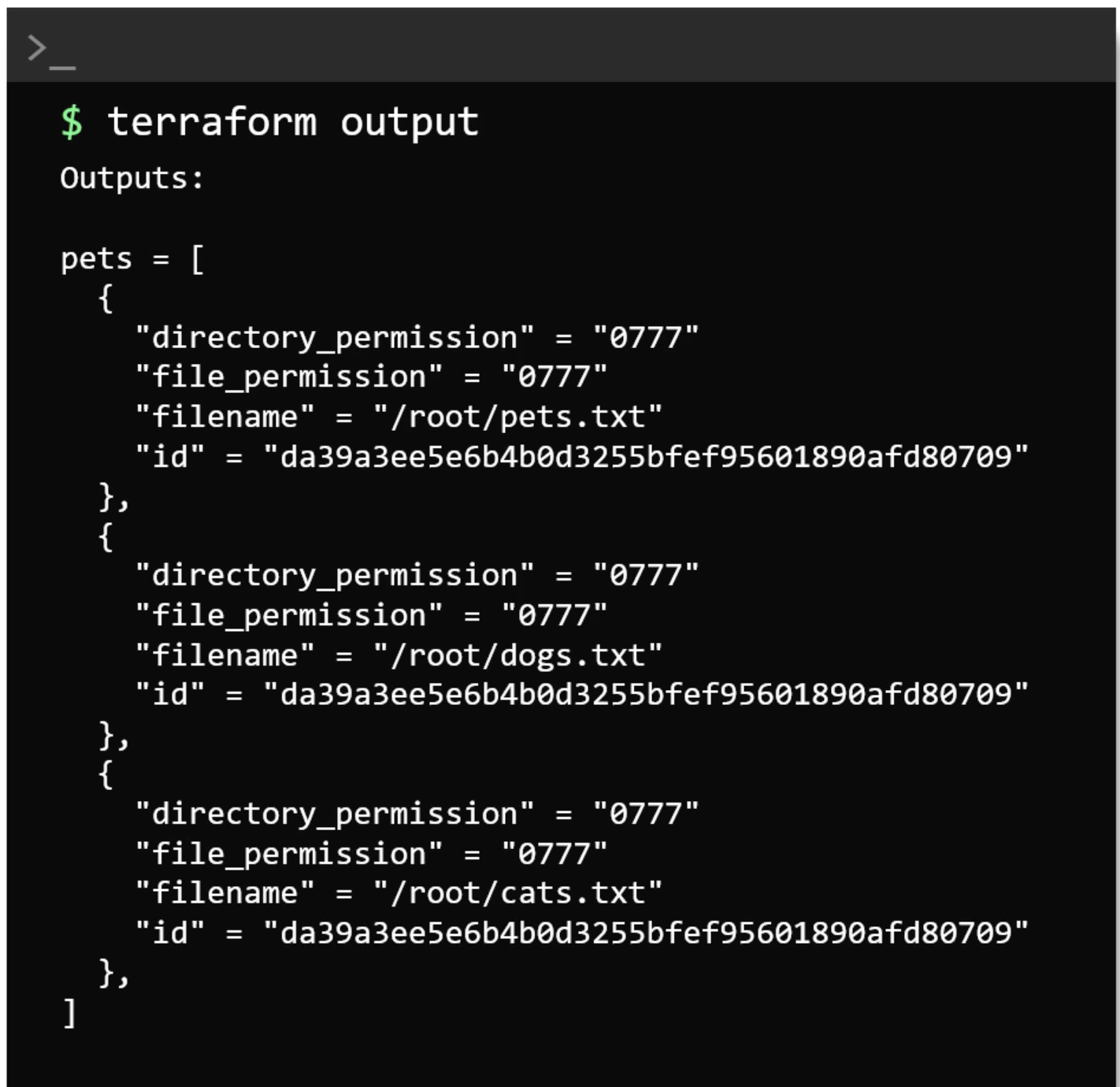
Understand Results

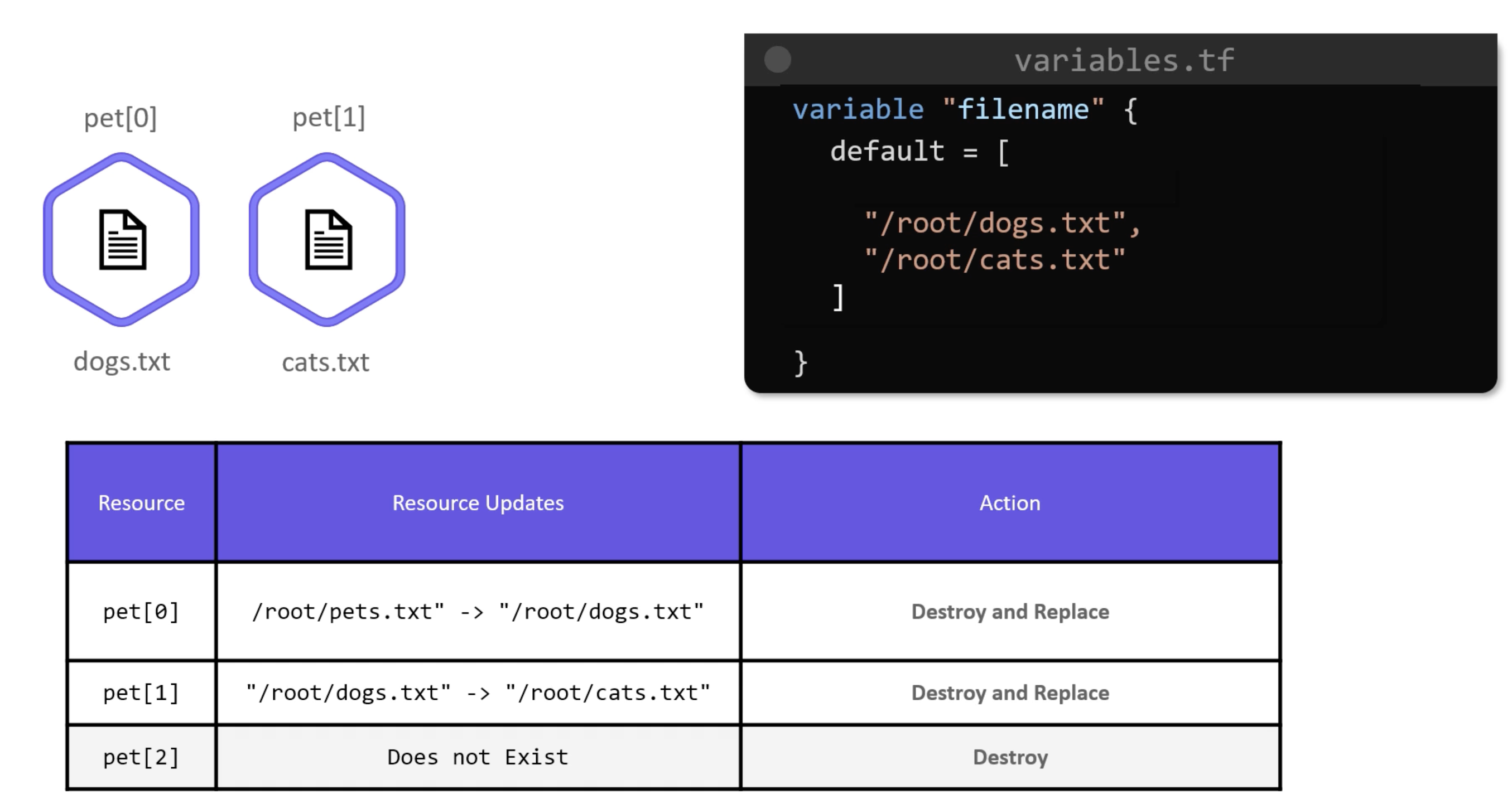
Yes now we have the infrastructure as we intended. But this is not the ideal approach.
For Each
- v1
- v2
variable "filename" {
type = set(string)
default = [
"/root/pets.txt",
"/root/dogs.txt",
"/root/cats.txt",
"/root/cows.txt",
"/root/whales.txt"
]
}
resource "local_file" "pet" {
filename = each.value
for_each = var.filename
}
variable "filename" {
type = list(string)
default = [
"/root/pets.txt",
"/root/dogs.txt",
"/root/cats.txt",
"/root/cows.txt",
"/root/whales.txt"
]
}
resource "local_file" "pet" {
filename = each.value
for_each = toset(var.filename)
}
Count vs For Each
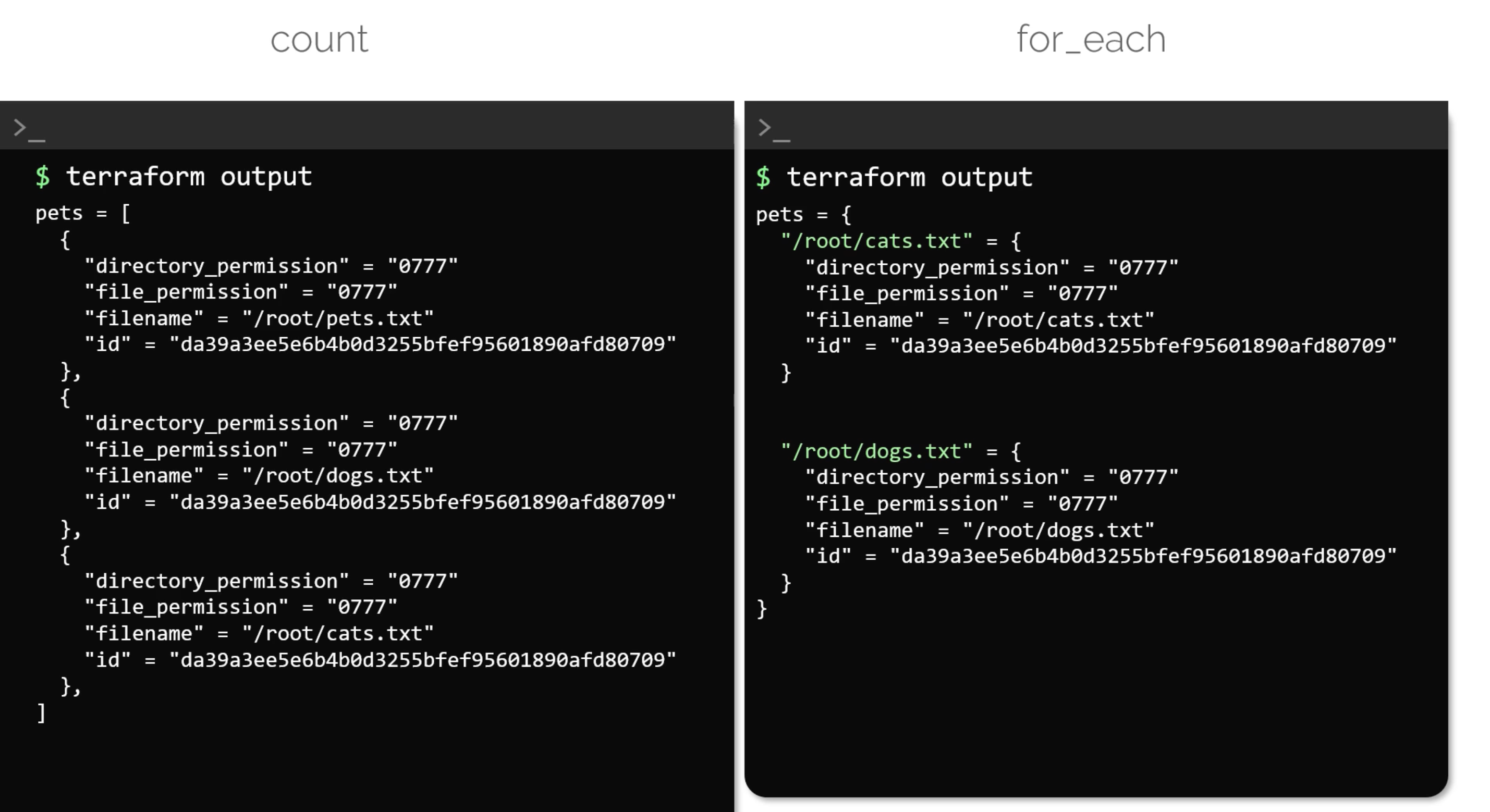
Other
There are other meta arguments in Terraform, e.g.:
provisioner.providers.backends.
Version Constraints
Providers use plugin-based architecture. By default, Terraform will download the latest version of the plugin. But you can specify the version of the plugin to use.
- Fixed Version
- Any Except
- Less Than
- Greater Than
- Range
- Semantic
terraform {
required_providers {
local = {
source = "hashicorp/local"
version = "2.4.1"
}
}
}
terraform {
required_providers {
local = {
source = "hashicorp/local"
version = "!= 2.4.1"
}
}
}
terraform {
required_providers {
local = {
source = "hashicorp/local"
version = "< 2.4.1"
}
}
}
terraform {
required_providers {
local = {
source = "hashicorp/local"
version = "> 2.4.1"
}
}
}
terraform {
required_providers {
local = {
source = "hashicorp/local"
version = "> 1.2.0, < 2.0.0, != 1.5.0"
}
}
}
terraform {
required_providers {
local = {
source = "hashicorp/local"
version = "~> 1.2"
}
}
}
In version = "~> 1.2", the ~> is a shorthand for >=. It means that the version should be greater than or equal to 1.2 and less than 2.0.
In version = "~> 1.2.0", the ~> is a shorthand for >=. It means that the version should be greater than or equal to 1.2.0 and less than 1.3.0.
AWS
You can use heredoc to write the policy document in a separate file. And then use the file function to read the file and pass it to the policy attribute.
Heredoc is a way to write multi-line strings. It is used to write a string that spans multiple lines. It starts with << followed by a delimiter. And ends with the same delimiter.
IAM
A quick review
Iam policies.
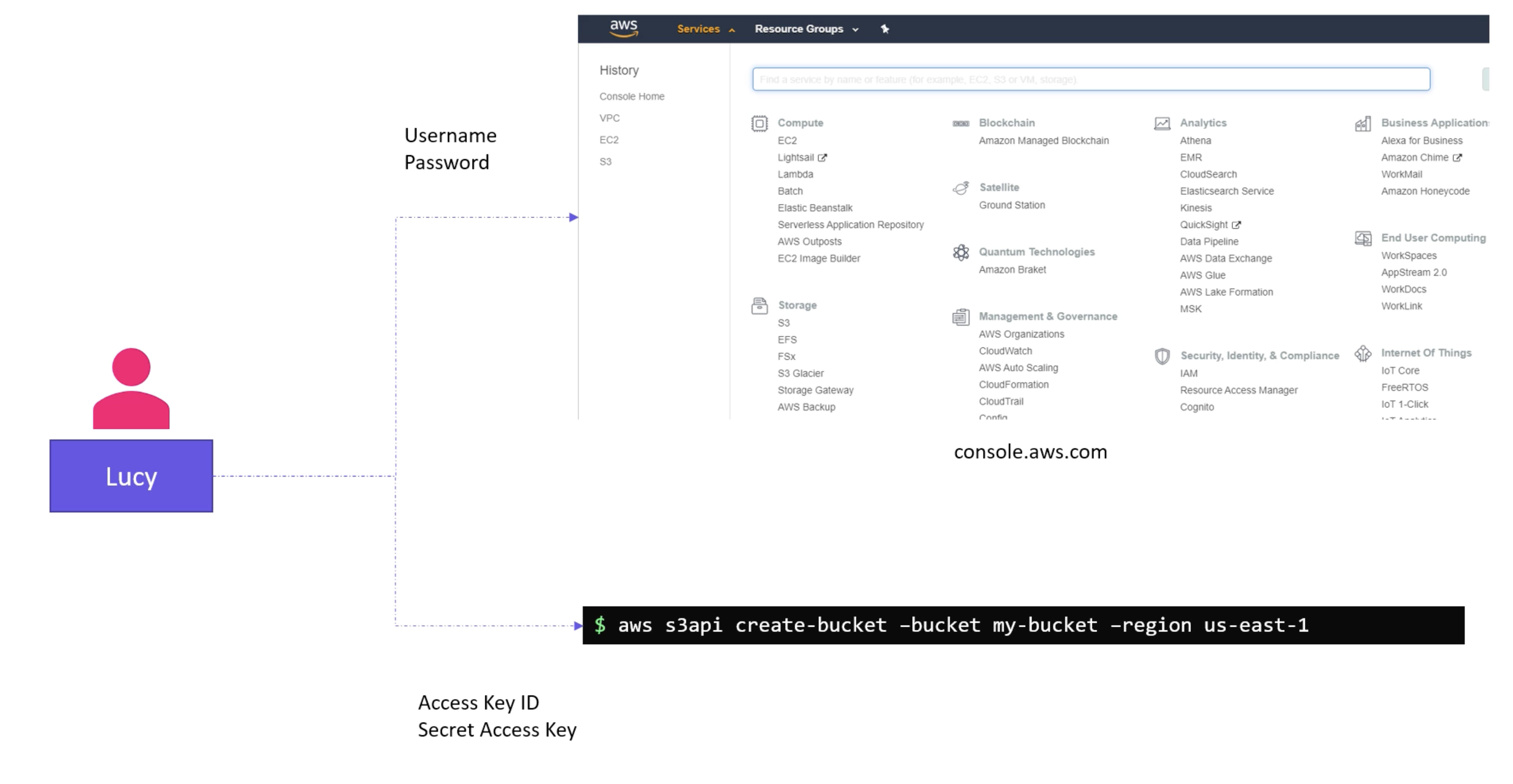
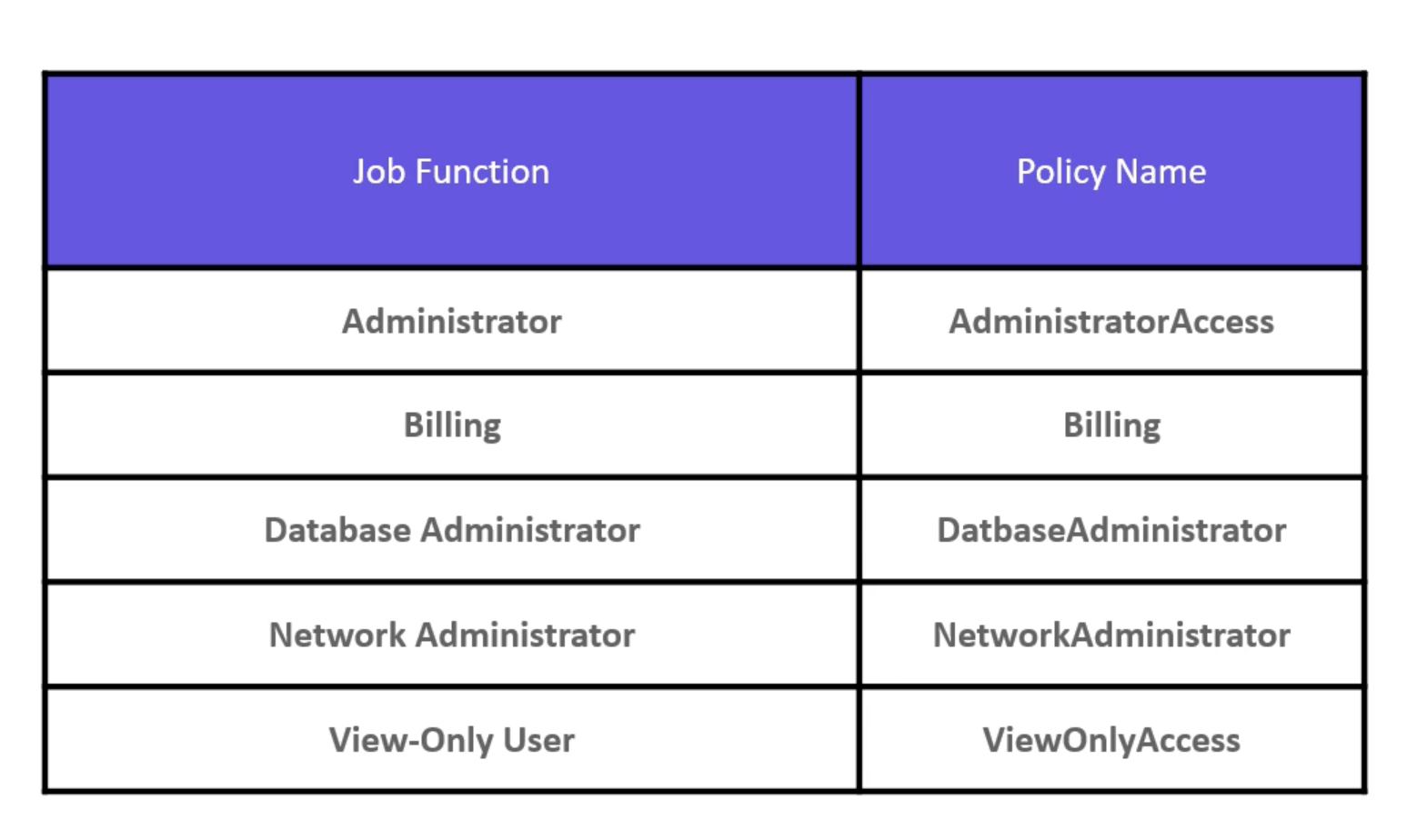
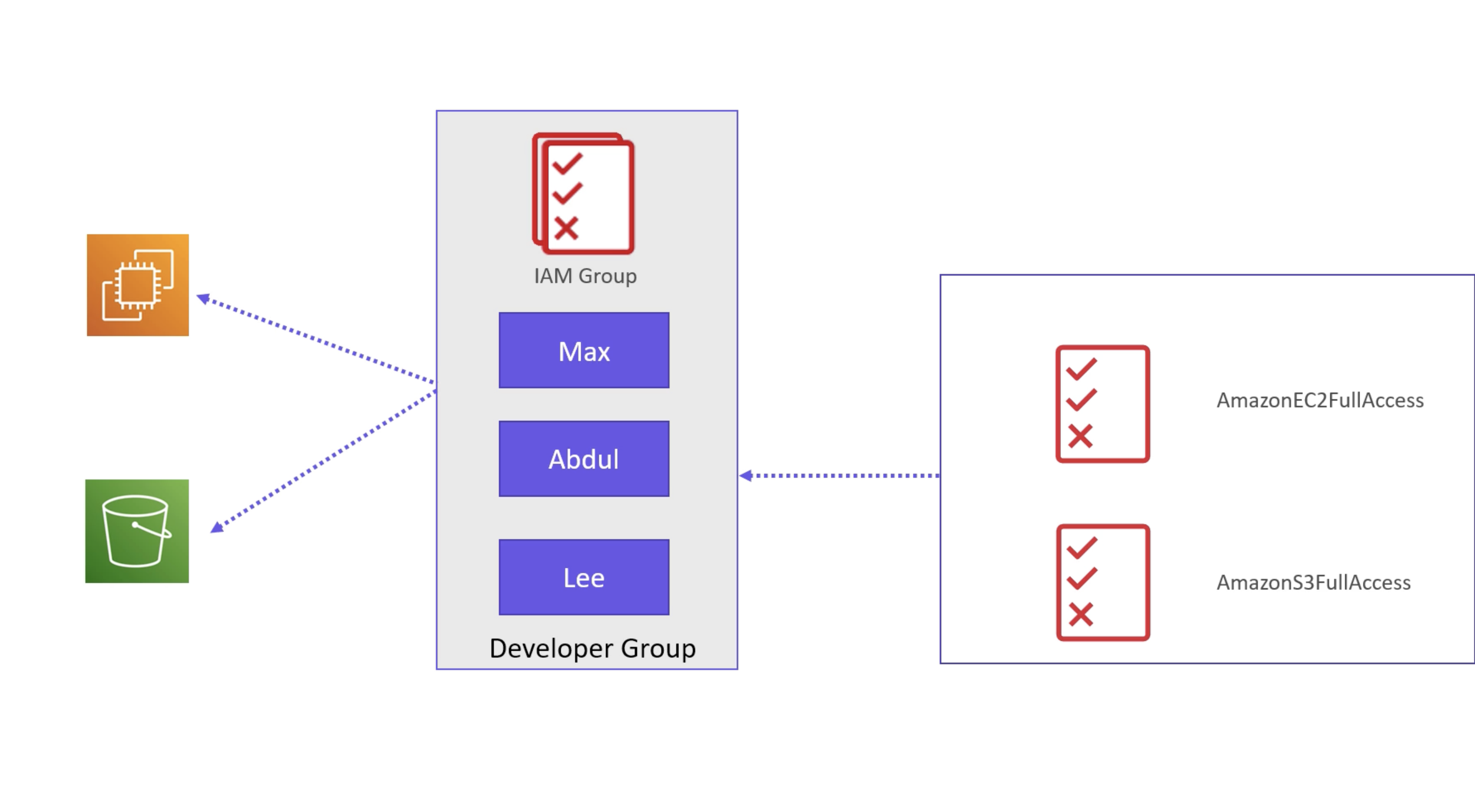
- IAM policies are attached to users, groups, and roles.
- IAM roles are used to delegate permissions to entities that you trust. E.g. a service or a user in another account.
IAM & IaC
resource "aws_iam_user" "admin-user" {
name = "ziadh"
tags = {
Description = "Technical Team Leader"
}
}
resource "aws_iam_policy" "adminUser" {
name = "adminUser"
description = "Admin User Policy"
policy = <<EOF
{
"Version": "2012-10-17",
"Statement": [
{
"Effect": "Allow",
"Action": "*",
"Resource": "*"
}
]
}
EOF
}
resource "aws_iam_user_policy_attachment" "adminUser" {
user = aws_iam_user.admin-user.name
policy_arn = aws_iam_policy.adminUser.arn
}
S3 & IaC
terraform {
required_providers {
aws = {
source = "hashicorp/aws"
version = "4.15.0"
}
}
}
provider "aws" {
region = "us-east-1"
}
resource "aws_s3_bucket" "dc_bucket" {
bucket = "dc-is-better-than-marvel"
}
resource "aws_s3_object" "upload" {
bucket = "pixar-studios-2020"
key = "woody.jpg"
source = "/root/woody.jpg"
}
DynamoDB & IaC
terraform {
required_providers {
aws = {
source = "hashicorp/aws"
version = "4.15.0"
}
}
}
provider "aws" {
region = var.region
skip_credentials_validation = true
skip_requesting_account_id = true
endpoints {
dynamodb = "http://aws:4566"
}
}
resource "aws_dynamodb_table" "project_sapphire_inventory" {
name = "inventory"
billing_mode = "PAY_PER_REQUEST"
hash_key = "AssetID"
attribute {
name = "AssetID"
type = "N"
}
attribute {
name = "AssetName"
type = "S"
}
attribute {
name = "age"
type = "N"
}
attribute {
name = "Hardware"
type = "B"
}
global_secondary_index {
name = "AssetName"
hash_key = "AssetName"
projection_type = "ALL"
}
global_secondary_index {
name = "age"
hash_key = "age"
projection_type = "ALL"
}
global_secondary_index {
name = "Hardware"
hash_key = "Hardware"
projection_type = "ALL"
}
}
resource "aws_dynamodb_table_item" "upload" {
table_name = aws_dynamodb_table.project_sapphire_inventory.name
hash_key = aws_dynamodb_table.project_sapphire_inventory.hash_key
item = <<EOF
{
"AssetID": {"N": "1"},
"AssetName": {"S": "printer"},
"age": {"N": "5"},
"Hardware": {"B": "true" }
}
EOF
}
EC2 & IaC
# [1]: Prepare ssh key pair
resource "tls_private_key" "ssh_key" {
algorithm = "ED25519"
}
output "private_key" {
value = tls_private_key.ssh_key.private_key_openssh
sensitive=true
}
output "public_key" {
value = tls_private_key.ssh_key.public_key_openssh
sensitive=true
}
resource "local_file" "ssh_key_pair" {
filename = "ssh_key_pair"
content = tls_private_key.ssh_key.private_key_openssh
}
resource "local_file" "ssh_key_pair_pub" {
filename = "ssh_key_pair.pub"
content = tls_private_key.ssh_key.public_key_openssh
}
resource "aws_eip" "lb" {
domain = "vpc"
instance = aws_instance.ubuntu-latest-server.id
}
# [2]: Create EC2 instance
resource "aws_instance" "ubuntu-latest-server" {
ami = "ami-0c55b159cbfafe1f0"
instance_type = "t2.micro"
key_name = tls_private_key.ssh_key.key_name
vpc_security_group_ids = [
aws_security_group.ssh_access.id
]
tags = {
Name = "ubuntu-latest-server"
}
}
# [3]: Security group SSH access
resource "aws_security_group" "ssh_access" {
name = "ssh_access"
description = "Allow SSH access"
vpc_id = "vpc-0c55b159cbfafe1f0"
ingress {
description = "Allow SSH access from anywhere"
from_port = 22
to_port = 22
protocol = "tcp"
cidr_blocks = ["0.0.0.0/0"]
}
}
output "public_ip" {
value = aws_instance.ubuntu-latest-server.public_ip
}
Remote State
- You should never attempt to modify the state file manually.
- You should never store the state file in a version control system.
Use a remote backend to store the state file. E.g. Terraform Cloud, S3, Azure Blob Storage, ...etc.
You can check the following articles:
Reasons
- Forgot to pull the latest state file from the repo.
Disaster. - No state locking mechanism.
Concurrency issues. - Bad practice to expose sensitive data
ip-addresses, dns, db passwords..etc" residing inside the state file.Security issues`.
State Commands
We have several commands to manage the state file, e.g.:
- list.
- mv.
- pull.
- rm.
- show.
list
terraform state list # Print resource addresses
show
terraform state show aws_instance.example # Show details of a resource
mv
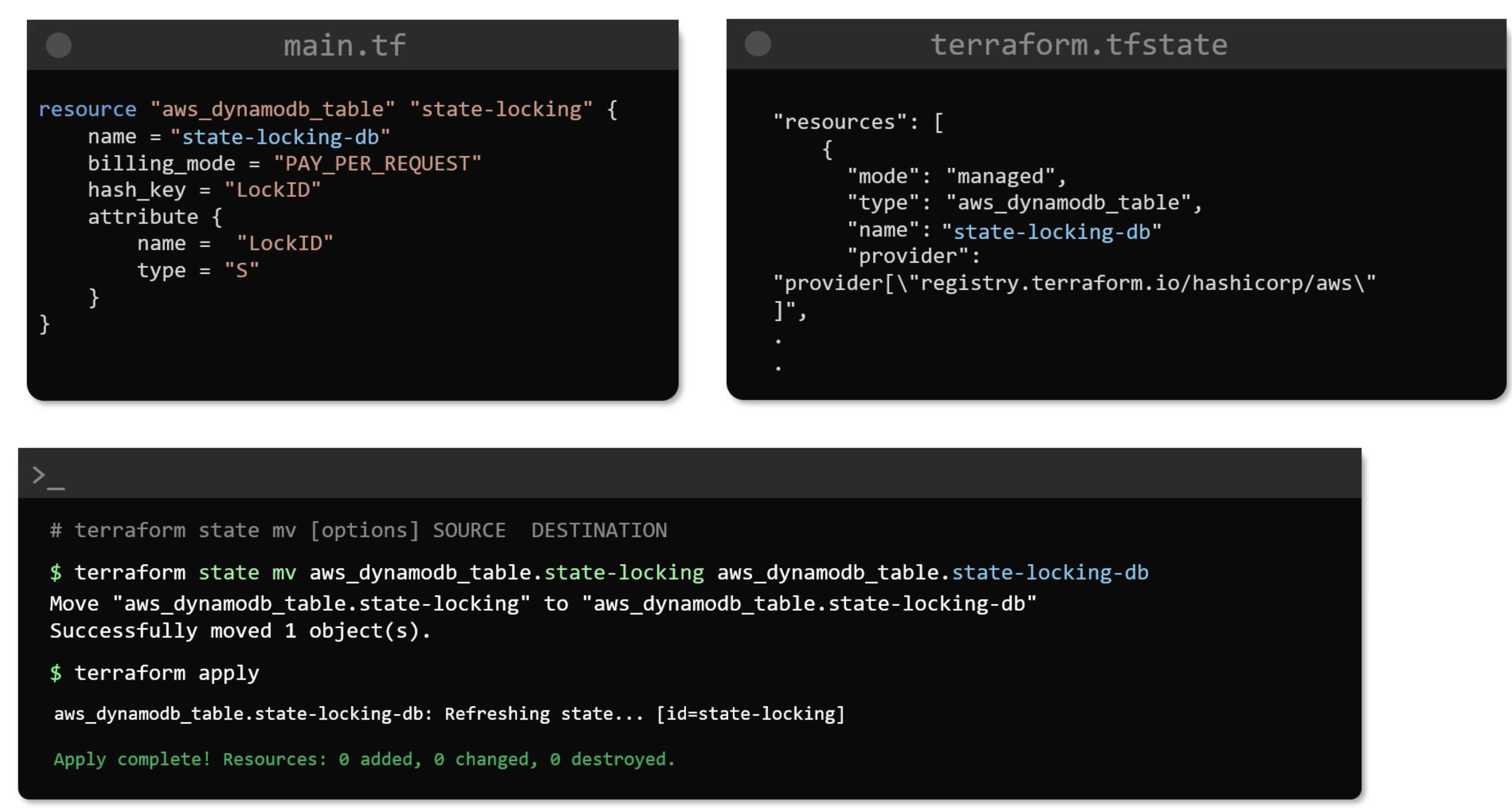
pull
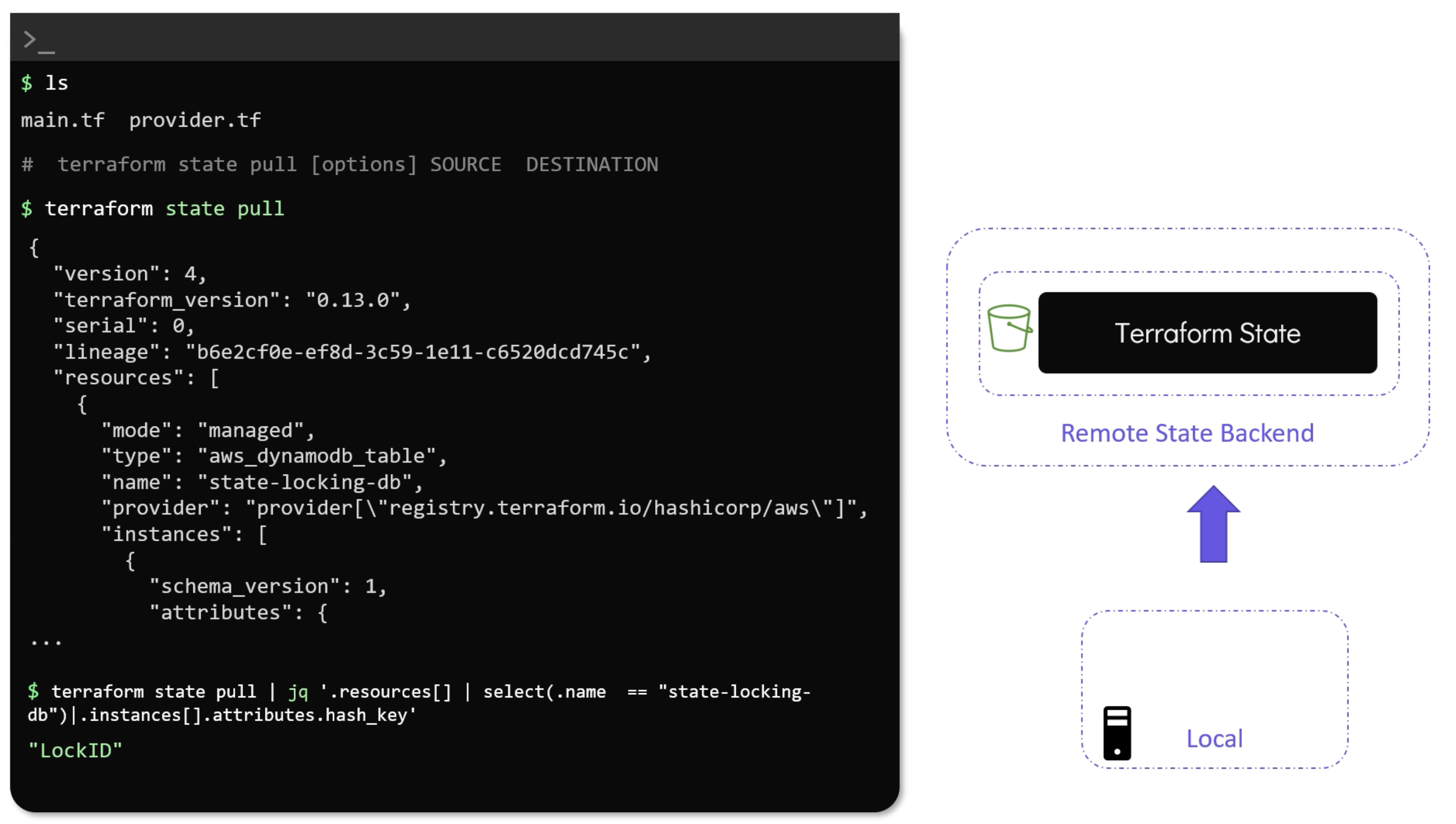
rm
But make sure to remove the resource from the configuration file first. Otherwise, Terraform will try to recreate the resource. Also note that the resource will not be destroyed in the real-world infrastructure. It will only be removed from the state file.
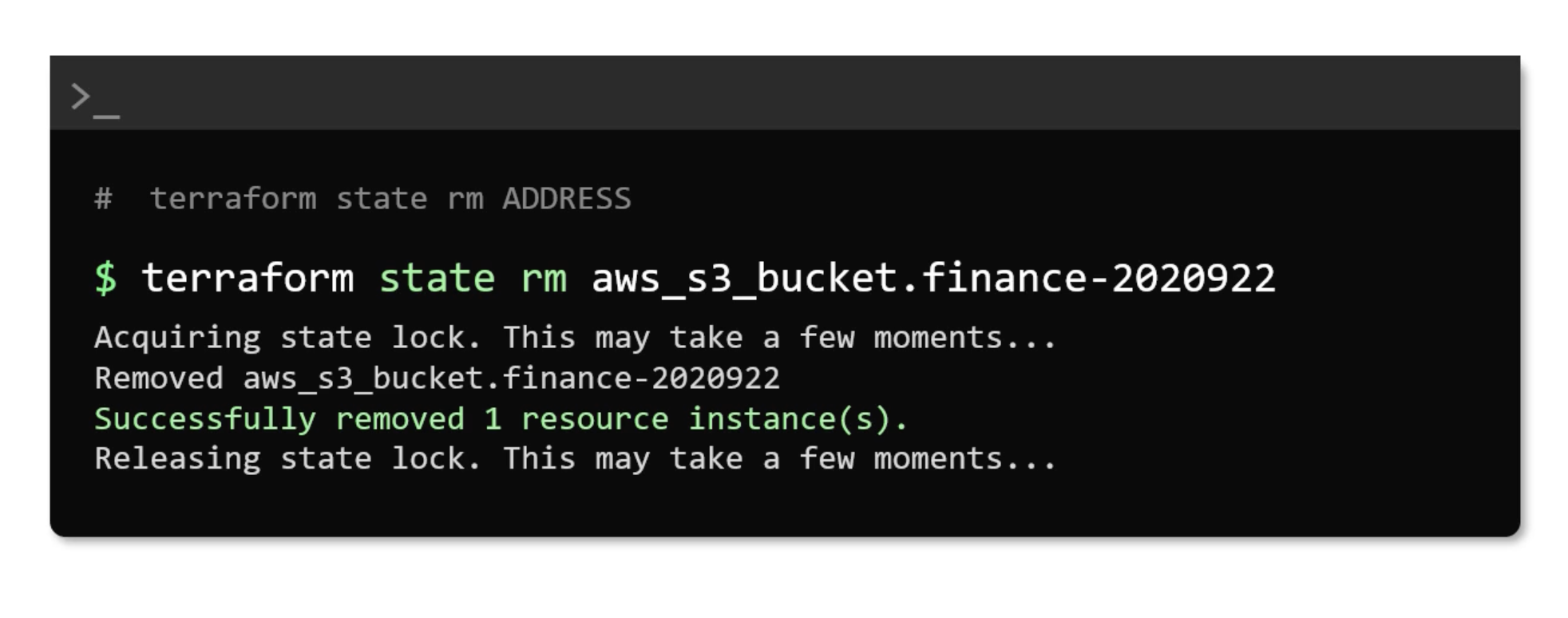
Provisioners
Provisioners are used to execute scripts on a local or remote machine as part of resource creation or destruction. They are used to bootstrap the resource, e.g.:
- Install software.
- Configure the resource.
- Run a script.
As a best practice, you should avoid using provisioners as much as possible. According to terraform documentation, Provisioners should only be used as a last resort. For example, when existing resources are not supported by Terraform.
Whenever possible make use of options natively supported by the provider. E.g.:
user_datafor EC2.initfor GCP.startup_scriptfor Azure.
user_data is only executed on the first boot of the instance. If you want to run a script every time the instance is booted, you should use a provision
resource "aws_instance" "cerberus" {
ami = var.ami
instance_type = var.instance_type
key_name = aws_key_pair.cerberus-key.key_name
user_data = <<EOF
#!/bin/bash
sudo yum update -y
sudo yum install nginx -y
sudo systemctl start nginx
EOF
}
Adding user data later won't install nginx.
Remote Exec
resource "aws_instance" "example" {
ami = "ami-0c55b159cbfafe1f0"
instance_type = "t2.micro"
provisioner "remote-exec" {
inline = [
"sudo apt update",
"sudo apt install -y nginx",
"sudo systemctl start nginx",
"sudo systemctl enable nginx"
]
}
connection {
type = "ssh"
user = "ubuntu"
host = self.public_ip
private_key = tls_private_key.ssh_key.private_key_openssh
}
}
No guarantee that the script will run successfully. There must exist a network connection between the local machine and the remote machine.
Also, provisioners are not included in plan output. As you can put any command in the provisioner. So, Terraform will not be able to predict the changes that will be made to the infrastructure.
Local Exec
Useful to gather some data and store it in a file. E.g.:
- Public IP address.
- Instance ID.
- DNS name.
resource "aws_instance" "example" {
ami = "ami-0c55b159cbfafe1f0"
instance_type = "t2.micro"
provisioner "local-exec" {
command = "echo ${self.public_ip} > ip_address.txt"
}
provisioner "local-exec" {
when = destroy
command = "echo ${self.public_ip} > ip_address.txt"
}
}
By default, provisioners are executed after the resource is created.
But, destroy time provisioners are executed before the resource is destroyed. It is useful to clean up the resources before they are destroyed.
Here /temp is a directory that does not exist. So, the command will fail. But we can use on_failure to continue the execution of the script. As we don't want the failure of the script to stop the execution of the resource.
resource "aws_instance" "example" {
ami = "ami-0c55b159cbfafe1f0"
instance_type = "t2.micro"
provisioner "local-exec" {
command = "echo ${self.public_ip} > /temp/ip_address.txt"
on_failure = continue
}
}
Taint
Taint is used to mark a resource for recreation. It is useful when you want to recreate a resource without destroying and recreating the entire infrastructure.
terraform taint aws_instance.example
terraform untaint aws_instance.example
Debugging
You can set TF_LOG to one of the log levels (in order of decreasing verbosity) TRACE, DEBUG, INFO, WARN or ERROR to change the verbosity of the logs. Trace is the most verbose and info is the least verbose.
Example
export TF_LOG=TRACE

Setting TF_LOG to JSON outputs logs at the TRACE level or higher, and uses a parseable JSON encoding as the formatting.
The JSON encoding of log files is not considered a stable interface. It may change at any time, without warning. It is meant to support tooling that will be forthcoming, and that tooling is the only supported way to interact with JSON formatted logs.
You can store the logs permanently by setting TF_LOG_PATH to the path of the log file. E.g. TF_LOG_PATH=/tmp/terraform.log.
To disable logging to a file, use unset TF_LOG_PATH.
Import
Import is used to import existing infrastructure into the state file. It is useful when you have existing infrastructure that was created manually or by other tools. And you want to bring it under Terraform management.
terraform import aws_instance.example i-1234567890abcdef0
You will need to add the resource to the configuration file. And then run terraform plan to see the changes that will be made to the infrastructure. And then run terraform apply to apply the changes.
resource "aws_instance" "example" {
{# resource attributes #}
}
terraform show -json | jq '.values.root_module.resources[] | select(.type == "aws_instance" and .name == "jade-mw")'
Modules
Modules are used to organize the configuration into reusable units. They are used to create reusable components. E.g.:
- VPC module.
- EC2 module.
- RDS module.
Resources addresses are unique. So, you can't have two resources with the same address. But you can have two resources with the same name if they are in different modules.
Example
resource "aws_instance" "example" {
ami = "ami-0c55b159cbfafe1f0"
instance_type = "t2.micro"
}
Would be module.tut-app-uk.aws_instance.example if it was in a module called tut-app-uk.
Example
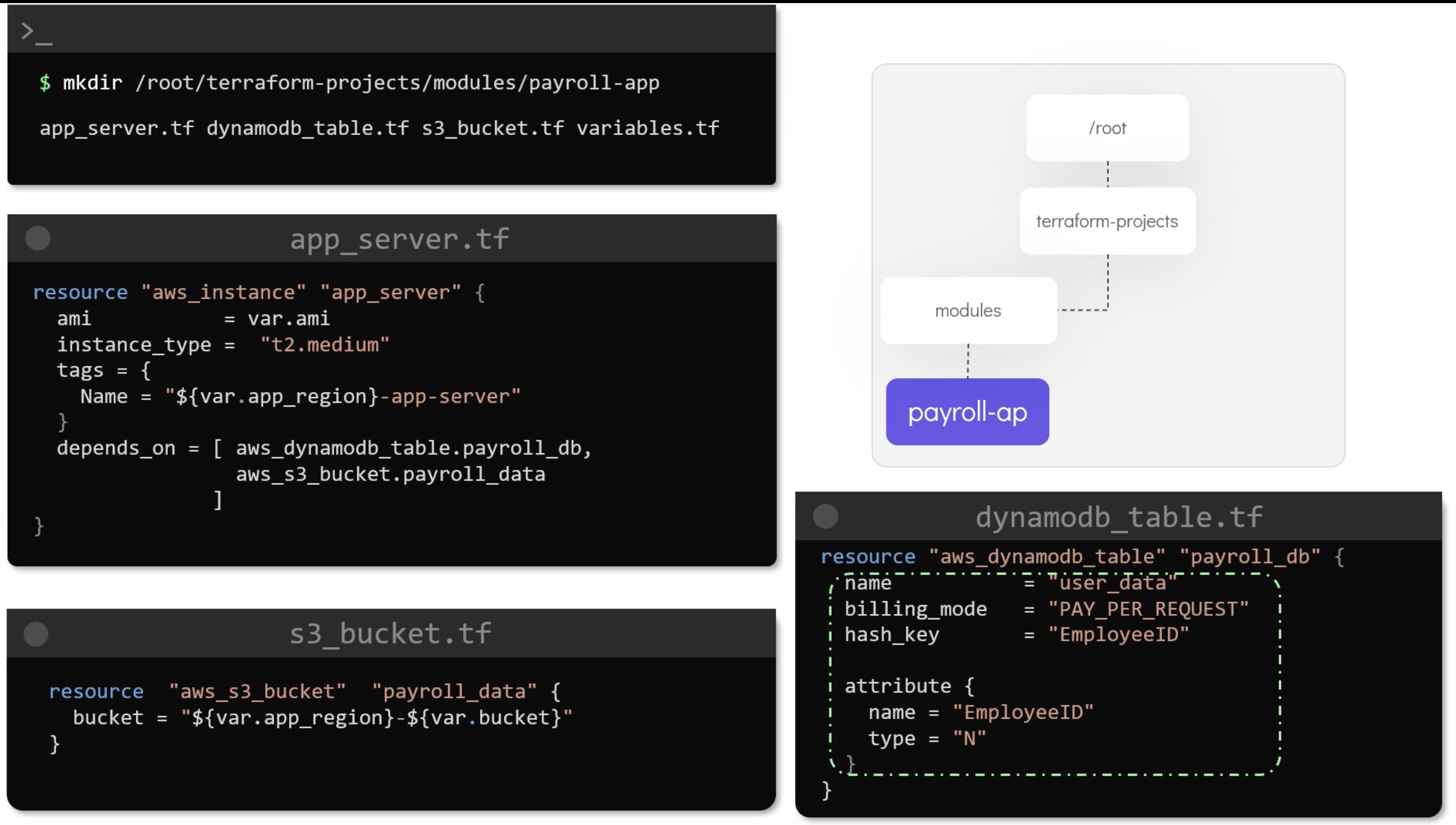
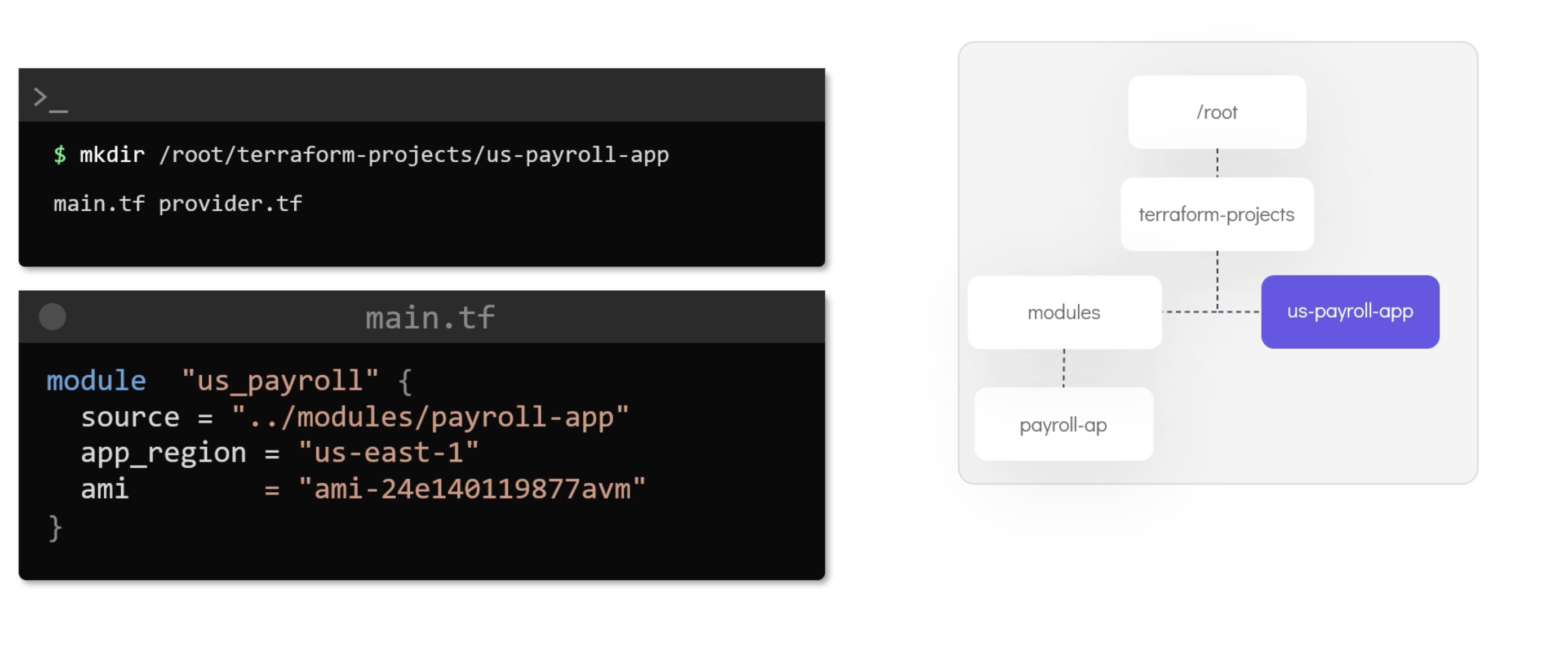
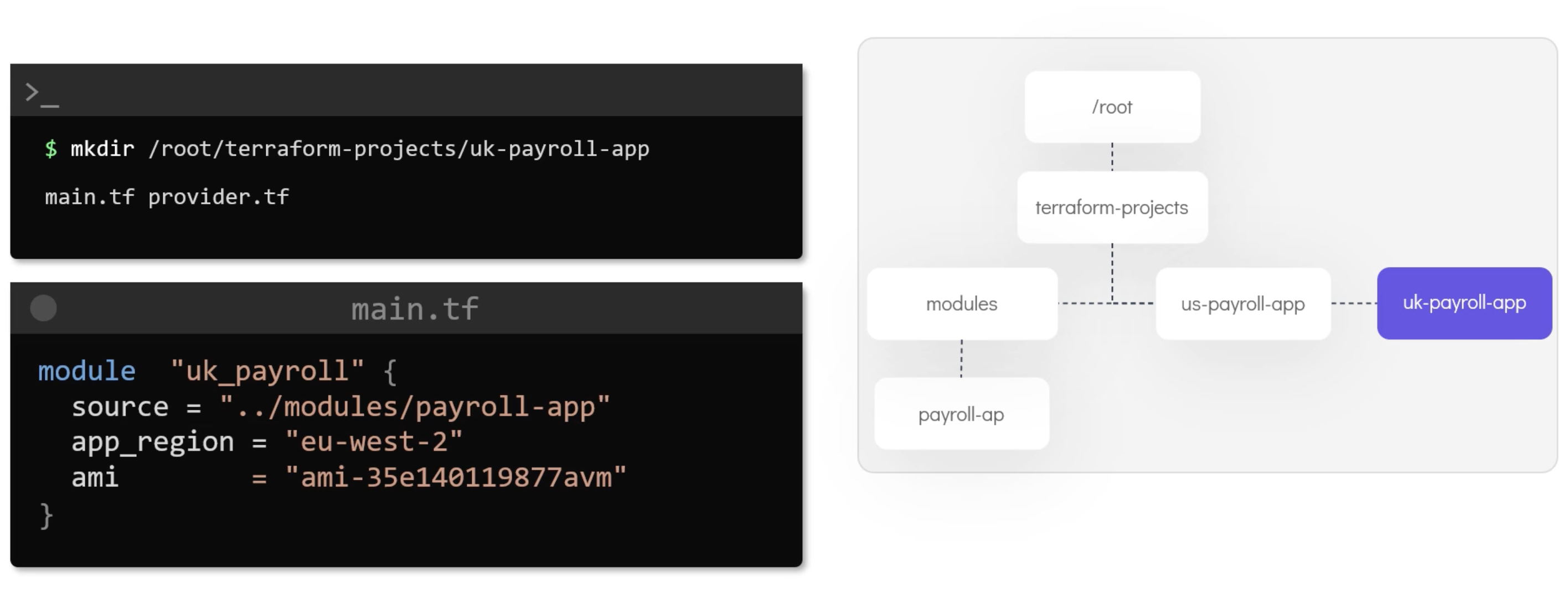
Functions
Terraform has a lot of built-in functions that you can use in your configuration files. E.g.:
abs.ceil.chomp.cidrsubnet.coalesce.coalescelist.compact.concat.contains.dirname.distinct.element.file.flatten.format.formatlist.
Console
terraform console
Example
terraform {
required_providers {
aws = {
source = "hashicorp/aws"
version = "4.15.0"
}
}
}
provider "aws" {
region = var.region
skip_credentials_validation = true
skip_requesting_account_id = true
s3_use_path_style = true
endpoints {
ec2 = "http://aws:4566"
iam = "http://aws:4566"
s3 = "http://aws:4566"
}
}
variable "region" {
default = "ca-central-1"
}
variable "cloud_users" {
type = string
default = "andrew:ken:faraz:mutsumi:peter:steve:braja"
}
variable "bucket" {
default = "sonic-media"
}
variable "media" {
type = set(string)
default = [
"/media/tails.jpg",
"/media/eggman.jpg",
"/media/ultrasonic.jpg",
"/media/knuckles.jpg",
"/media/shadow.jpg",
]
}
variable "sf" {
type = list
default = [
"ryu",
"ken",
"akuma",
"seth",
"zangief",
"poison",
"gen",
"oni",
"thawk",
"fang",
"rashid",
"birdie",
"sagat",
"bison",
"cammy",
"chun-li",
"balrog",
"cody",
"rolento",
"ibuki"
]
}
resource "aws_iam_user" "cloud" {
name = split(":", var.cloud_users)[count.index]
count = length(split(":", var.cloud_users))
}
Workspaces
variable "region" {
default = "us-west-1"
}
variable "instance_type" {
default = "t2.micro"
}
variable "ami" {
default = {
"ProjectA" = "ami-0c55b159cbfafe1f0",
"ProjectB" = "ami-0c55b159cbfafe1f0"
}
}
resource "aws_instance" "example" {
ami = lookup(var.ami, terraform.workspace)
instance_type = var.instance_type
tags = {
Name = "${terraform.workspace}-example"
}
}
terraform workspace new dev # adds and selects the workspace
terraform workspace new prod # adds and selects the workspace
terraform workspace list
terraform workspace select dev
terraform workspace select prod
State
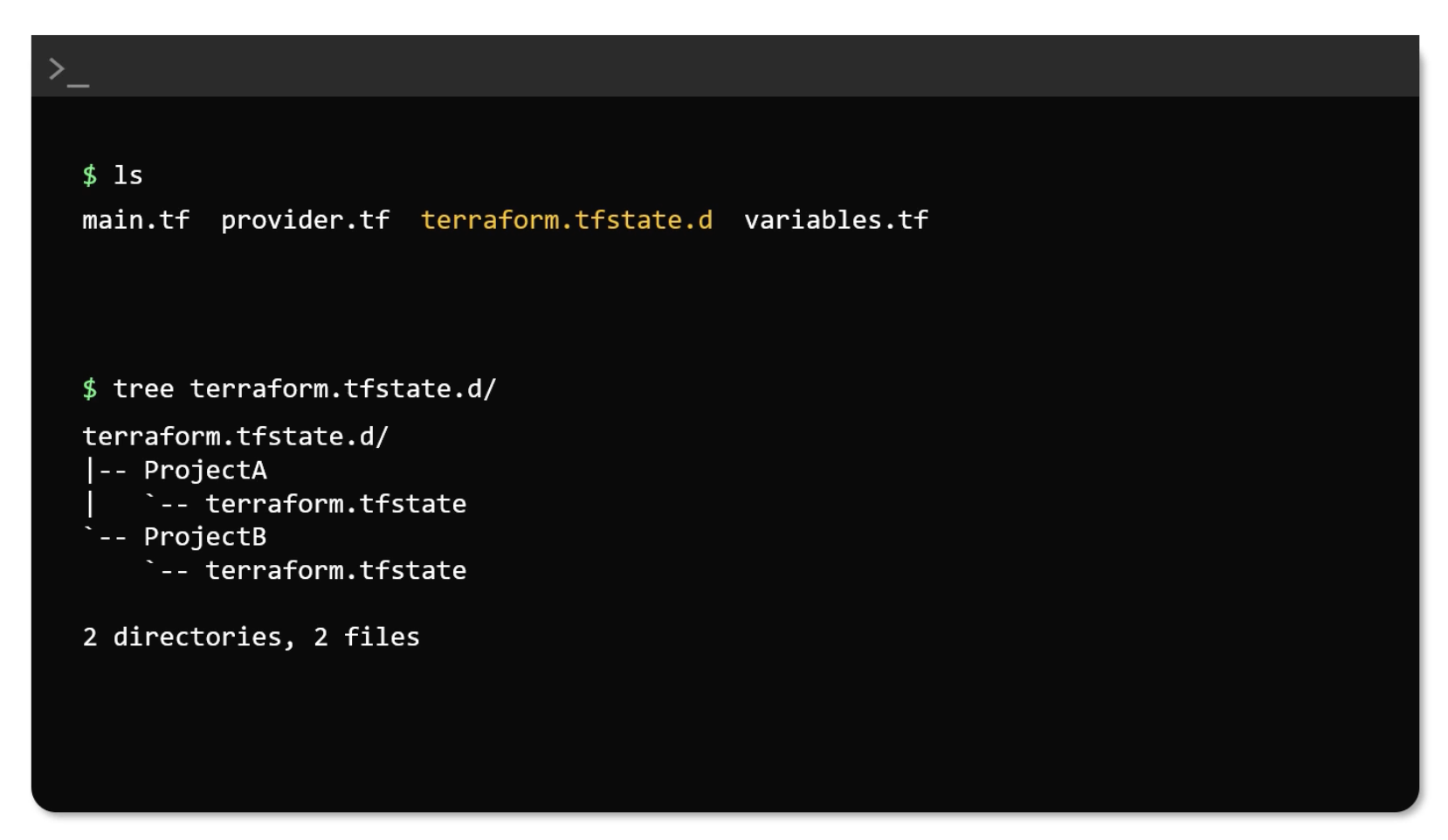
Providers
List of all providers examples.
tls
resource "tls_private_key" "pvtkey" {
algorithm = "RSA"
rsa_bits = 4096
}
resource "local_file" "key_details" {
filename = "/root/key.txt"
content = "${tls_private_key.pvtkey.private_key_pem}"
}
random
resource "random_uuid" "id1" {}
resource "random_integer" "order1" {
min = 1
max = 99999
}
output "id1" {
value = random_uuid.id1.result
}
output "order1" {
value = random_integer.order1.result
}
You can use the random_password resource to generate a random password. It is useful when you want to generate a random password for a user or a service.
terraform output -json | jq -r '.password.value'
variable "length" {
description = "The length of the password"
type = number
default = 16
}
resource "random_password" "password-generator" {
length = var.length < 16 ? 16 : var.length
special = true
override_special = "!@#$%^&*()_+"
}
output "password" {
value = random_password.password-generator.result
sensitive = true
}
